- BOAT OF THE YEAR
- Newsletters
- Sailboat Reviews
- Boating Safety
- Sailing Totem
- Charter Resources
- Destinations
- Galley Recipes
- Living Aboard
- Sails and Rigging
- Maintenance
- Best Marine Electronics & Technology


Sailboat Design Evolution
- By Dan Spurr
- Updated: June 10, 2020
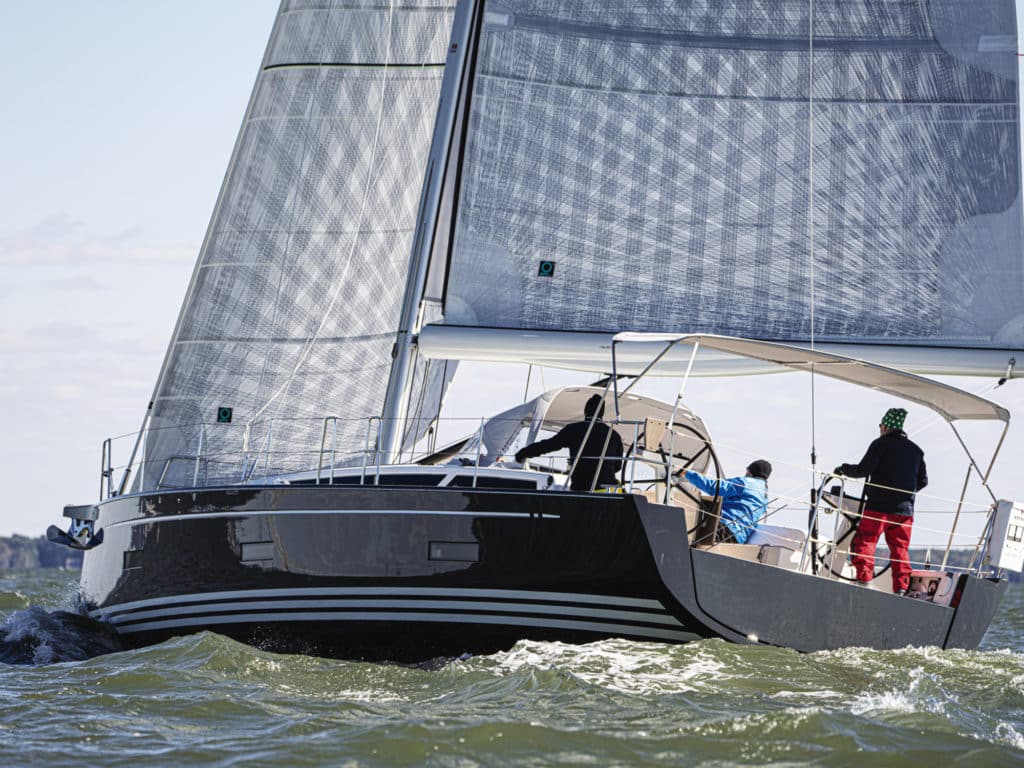
You know the old saying, “The more things change, the more they stay the same”? As a judge for the 2020 Boat of the Year (BOTY) competition at this past fall’s US Sailboat Show in Annapolis, Maryland, I helped inspect and test-sail 22 brand-new current-model sailboats. And I came away thinking, Man, these aren’t the boats I grew up on. In the case of new boats, the saying is wrong: “Nothing stays the same.”
OK, sure, today’s boats still have masts and sails, and the monohulls still have keels. But comparing the Hinckley Bermuda 40, considered by many to be one of the most beautiful and seaworthy boats of the 1960s, ’70s and even ’80s, with, say, the Beneteau First Yacht 53, which debuted at the show, is pretty much apples and oranges.
To get a better sense of what has happened to yacht design, boatbuilding and equipment over the past three, four or even six decades, let’s take a closer look.
Design Dilemmas
At the risk of oversimplification, since the fiberglass era began in the late 1940s and ’50s, the design of midsize and full-size yachts has transitioned from the Cruising Club of America rules, which favored all-around boats (racers had to have comfortable interiors) with moderate beam and long overhangs, to a succession of racing rules such as the IOR, IMS and IRC. All of them dictated proportions, and each required a measurer to determine its rating.
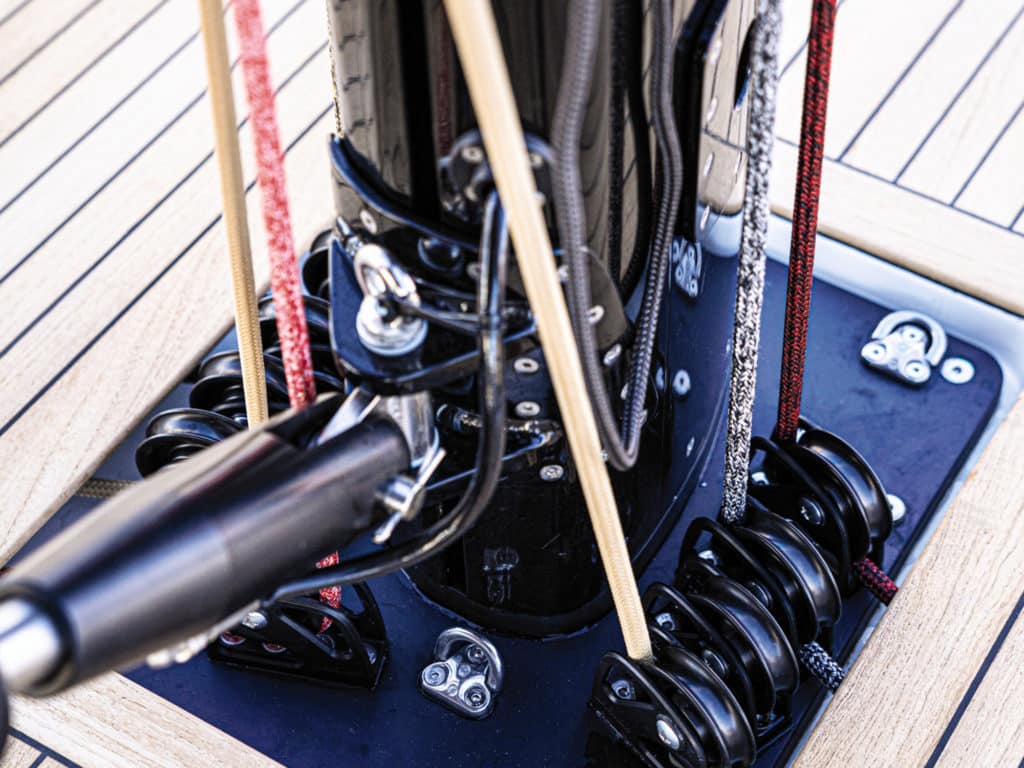
As frustration grew with each (no handicap rule is perfect), alternatives arose, such as the Performance Handicap Racing Fleet, which essentially based one’s handicap on past performance of the same boats in the same fleet. Also, one-design racing became more popular, which spread beyond identical small boats to full-size yachts, popularized in part by builders such as J/Boats and Carroll Marine. The ethos there was: Who cares about intricate rating rules? Let’s just go out and sail fast and have fun!
And that might best sum up the design briefs for the monohulls in this year’s BOTY competition: good all-around performance with comfortable, even luxurious accommodations. Gone are interiors that noted naval architect Robert Perry called “the boy’s cabin in the woods,” deeply influenced by stodgy British designers of the past century and their now-old-fashioned (though sea-friendly, one should note) concepts of a proper yacht, drawn and spec’d by the same guy who designed the hull, deck and rig. Today, dedicated European interior designers are specially commissioned to inject modernity, home fashion colors and textures, amenities, and more light—even dubiously large port lights in the topsides.
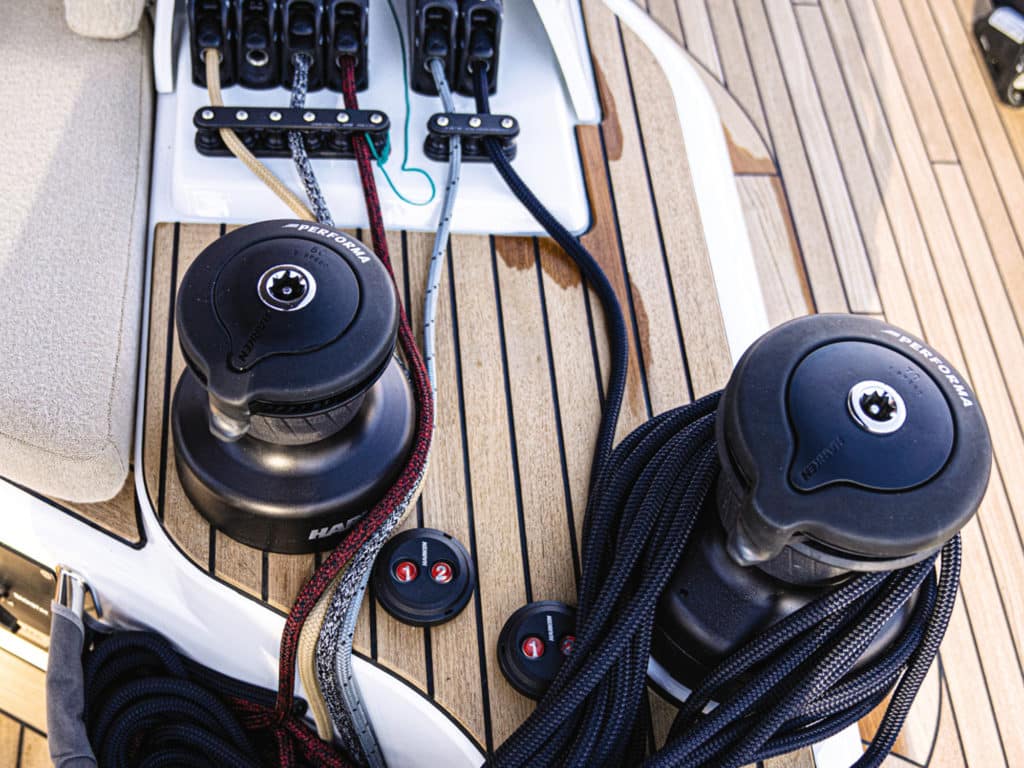
Overhangs, bow and stern, have virtually disappeared. Why? It seems largely a matter of style. Plus, the bonus of increased usable space below, not to mention a longer waterline length for a given length overall, which translates to more speed. Former naval architect for C&C Yachts and Hunter Marine, Rob Mazza, recalls that 19th-century pilot cutters and fishing schooners operating in offshore conditions generally had plumb bows, so in a sense, bow forms have come full circle.
Today’s boats are carrying their wide beam farther aft. Gone are the days of the cod’s head and mackerel tail. Wide, flat canoe bodies are decidedly fast off the wind, and might even surf, but they pay a comfort penalty upwind.
These boats have lighter displacement/length (D/L) ratios, which means flatter bottoms and less stowage and space for tanks. The Beneteau 53 has a D/L of 118, compared with the aforementioned Bermuda 40 of 373. Among entries in this year’s BOTY, the heaviest D/L belonged to the Elan Impression 45.1, with a D/L of 195. Recall that when Perry’s extremely popular Valiant 40 was introduced in 1975, the cruising establishment howled that its D/L of 267 was unsuitable for offshore sailing. My, how times have changed!
Perhaps more important, one must ask: “Have the requirements for a good, safe bluewater cruiser actually changed? Or are the majority of today’s production sailboats really best-suited for coastal cruising?”
The ramifications of lighter displacement don’t end there; designers must consider two types of stability: form and ultimate. As weight is taken out of the boat, beam is increased to improve form stability. And with tanks and machinery sometimes raised, ballast might have to be added and/or lowered to improve ultimate stability.
What else to do? Make the boat bigger all around, which also improves stability and stowage. Certainly the average cruising boat today is longer than those of the earlier decades, both wood and fiberglass. And the necessarily shallower bilges mean pumps must be in good shape and of adequate size. That’s not as immediate an issue with a deep or full keel boat with internal ballast and a deep sump; for instance, I couldn’t reach the bottom of the sump in our 1977 Pearson 365.
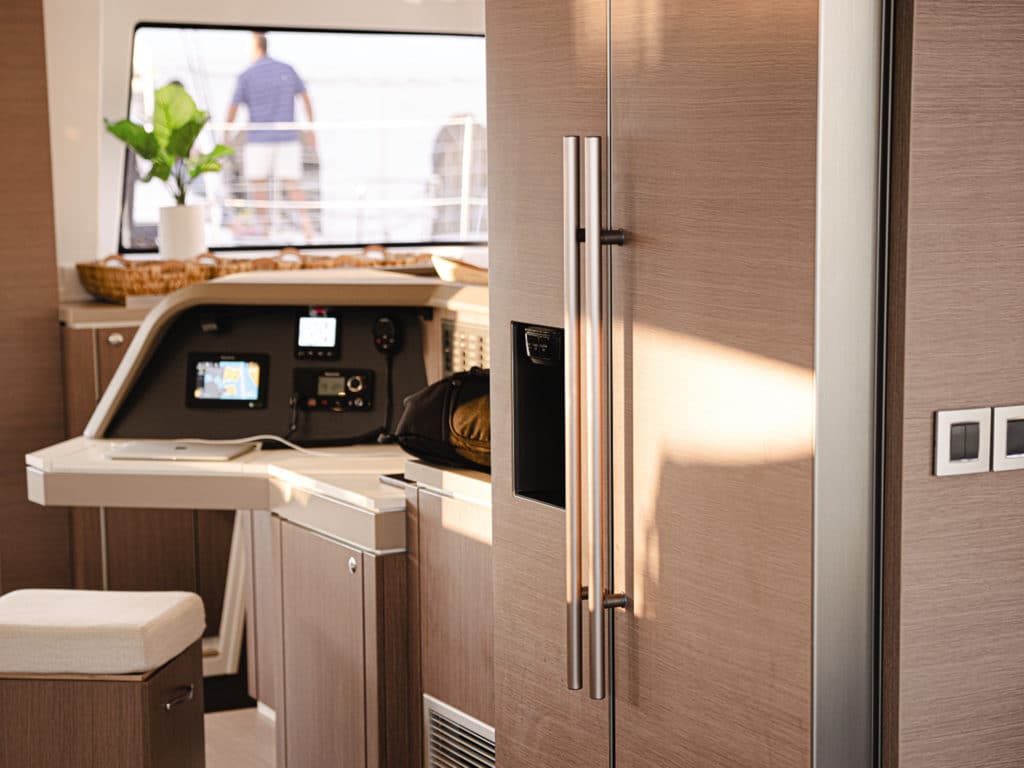
And how do these wide, shallow, lighter boats handle under sail? Like a witch when cracked off the wind. We saw this trend beginning with shorthanded offshore racers like those of the BOC Challenge round-the-world race in the early 1980s. As CW executive editor Herb McCormick, who has some experience in these boats, says, “They’ll knock your teeth out upwind.” But route planning allows designers to minimize time upwind, and cruisers can too…if you have enough room and distance in front of you. Coastal sailors, on the other hand, will inevitably find even moderate displacement boats more comfortable as they punch into head seas trying to make port.
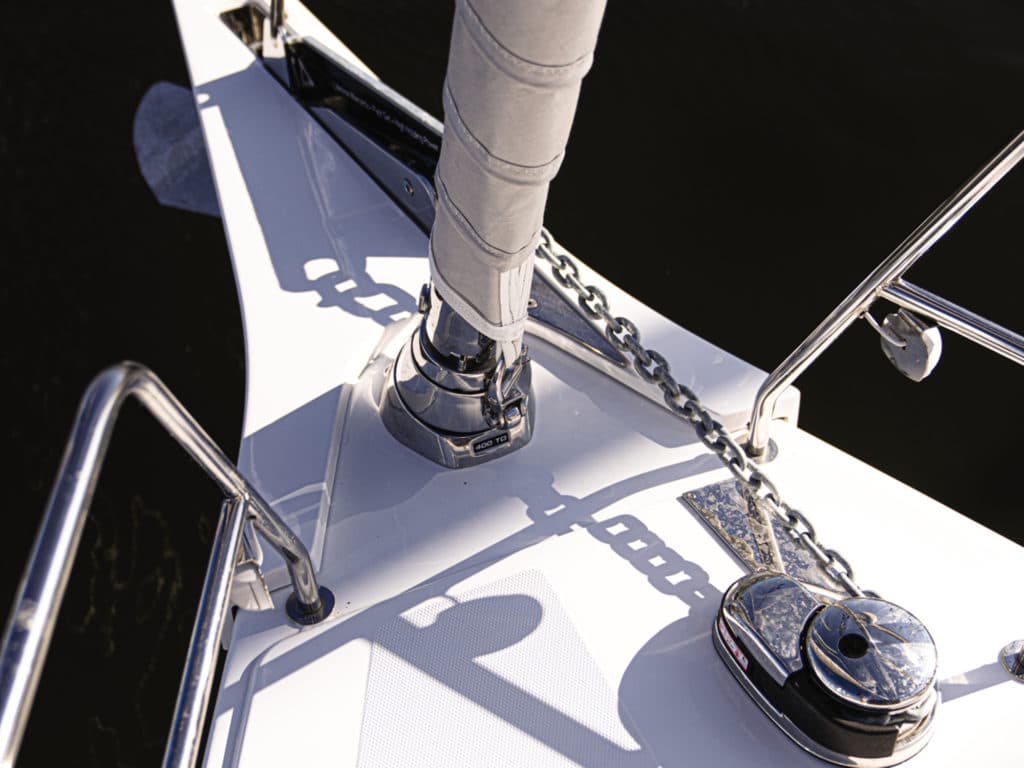
A wide beam carried aft permits a number of useful advantages: the possibility of a dinghy garage under the cockpit on larger boats; easy access to a swim platform and a launched dinghy; and twin helms, which are almost a necessity for good sightlines port and starboard. Of course, two of anything always costs twice as much as one.
Some multihulls now have reverse bows. This retro styling now looks space-age. Very cool. But not everyone is sold on them. Canadian designer Laurie McGowan wrote in a Professional BoatBuilder opinion piece, “I saw through the fog of faddishness and realized that reverse bows are designed to fail—that is, to cause vessels to plunge when lift is required.” Mazza concurs: “Modern multihulls often have reverse stems with negative reserve buoyancy, and those are boats that really can’t afford to bury their bows.”
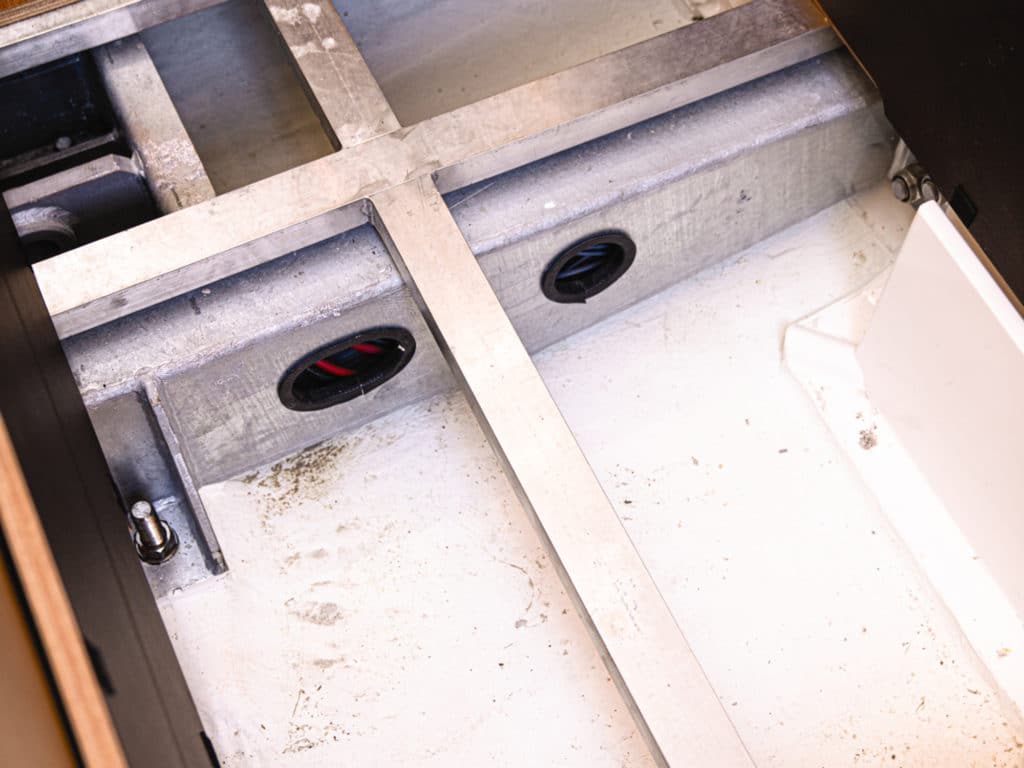
McGowan also cites another designer critiquing reverse bows for being noticeably wet and requiring alternative ground-tackle arrangements. The latter also is problematic on plumb bows, strongly suggesting a platform or sprit to keep the anchor away from the stem.
Rigging Redux
If there was a boat in Annapolis with double lower shrouds, single uppers, and spreaders perpendicular to the boat’s centerline, I must have missed it. I believe every boat we sailed had swept-back spreaders and single lowers. An early criticism of extreme swept-back spreaders, as seen on some B&R rigs installed on Hunter sailboats, was that they prevented fully winging out the mainsail. The counter argument was that so many average sailors never go dead downwind in any case, and broad reaching might get them to their destinations faster anyway—and with their lunch sandwiches still in their stomachs.
That issue aside, the current rigging configuration may allow for better mainsail shape. But as Mazza points out, it’s not necessarily simple: “By sweeping the spreaders, the ‘transverse’ rigging starts to add fore-and-aft support to the midsection of the mast as well, reducing the need for the forward lowers. However, spreader sweep really does complicate rig tuning, especially if you are using the fixed backstay to induce headstay tension. Swept spreaders do make it easier to sheet non-overlapping headsails, and do better support the top of the forestay on fractional rigs.”
Certainly, the days of 150 percent genoas are over, replaced by 100 percent jibs that fit perfectly in the foretriangle, often as a self-tacker.
Another notable piece of rigging the judges found common was some form of lazy jacks or mainsail containment, from traditional, multiple lines secured at the mast and boom; to the Dutchman system with monofilament run through cringles sewn into the sail like a window blind; to sailmaker solutions like the Doyle StackPak. This is good news for all sailors, especially those who sail shorthanded on larger boats.
Construction Codas
Improvements in tooling—that is, the making of molds—are easily evident in today’s boats, particularly with deck details, and in fairness. That’s because many of today’s tools are designed with computer software that is extraordinarily accurate, and that accuracy is transferred flawlessly to big five-axis routers that sculpt from giant blocks of foam the desired shape to within thousandths of an inch. Gone are the days of lofting lines on a plywood floor, taken from a table of offsets, and then building a male plug with wood planks and frames. I once owned a 1960s-era sailboat, built by a reputable company, where the centerline of the cockpit was 7 degrees off the centerline of the deck—and they were one piece!
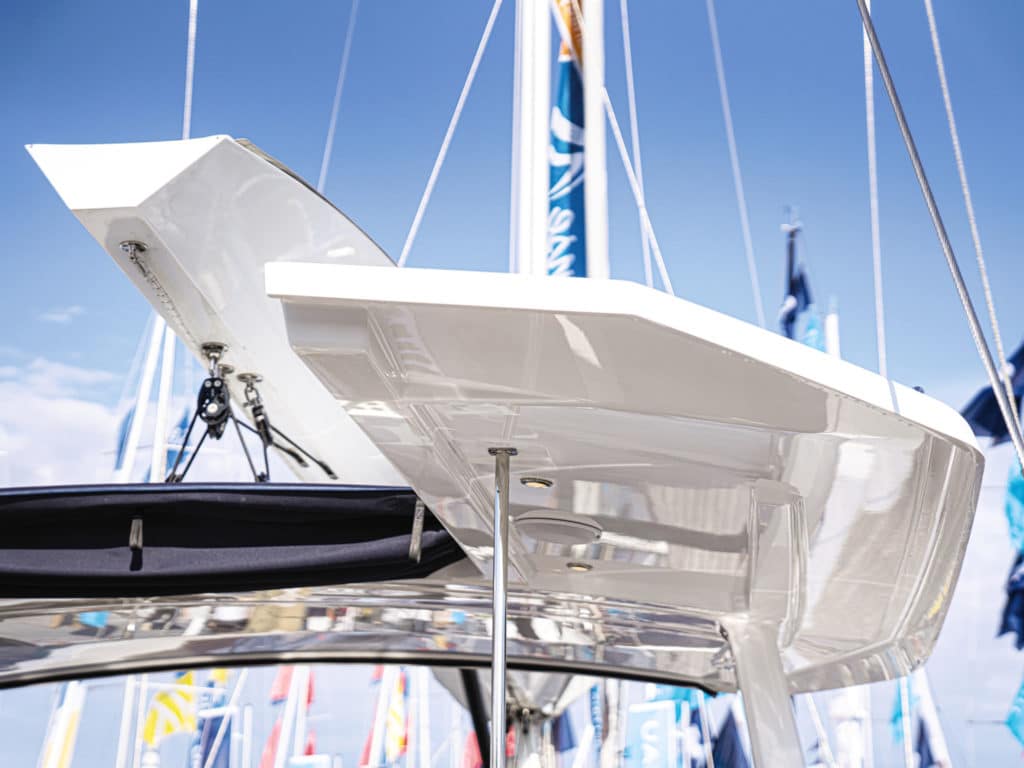
Additive processes, such as 3D printing, are quickly complementing subtractive processes like the milling described above. Already, a company in California has made a multipart mold for a 34-foot sailboat. Advantages include less waste materials.
Job training also has had an impact on the quality of fiberglass boats. There are now numerous schools across the country offering basic-skills training in composites that include spraying molds with gelcoat, lamination, and an introduction to vacuum bagging and infusion.
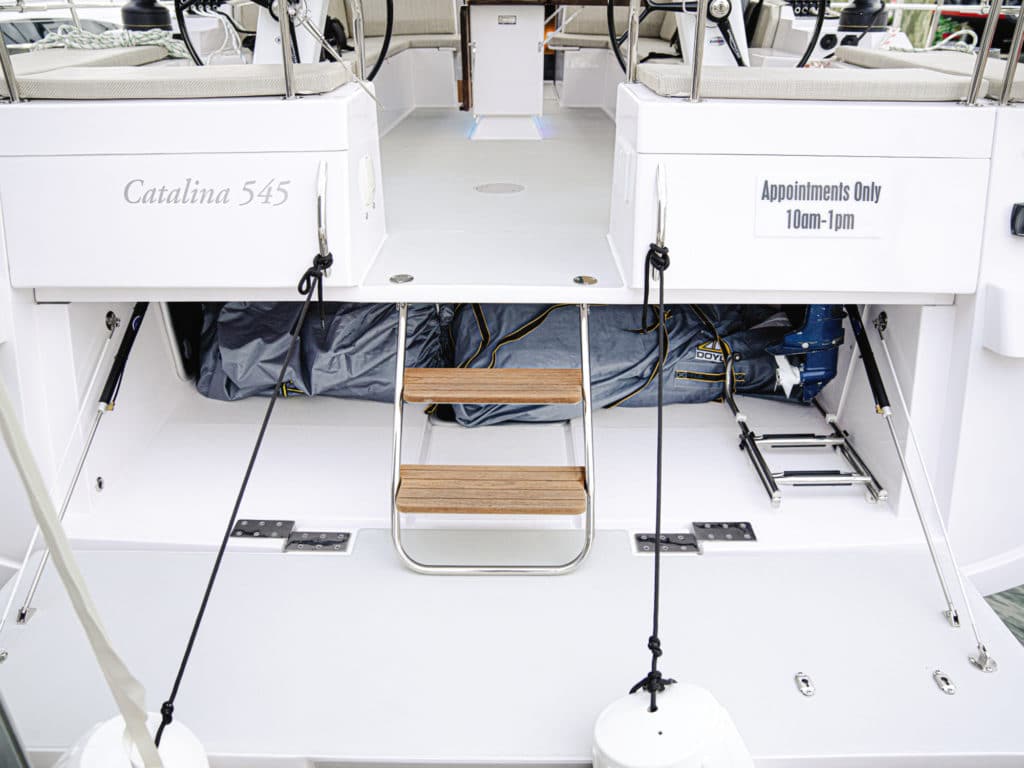
The patent on SCRIMP—perhaps the first widely employed infusion process—has long ago expired, but many builders have adopted it or a similar process whereby layers of fiberglass are placed in the mold dry along with a network of tubes that will carry resin under vacuum pressure to each area of the hull. After careful placement, the entire mold is covered with a bag, a vacuum is drawn by a pump, and lines to the pot of resin are opened. If done correctly, the result is a more uniform fiberglass part with a more controlled glass-to-resin ratio than is achievable with hand lay-up. And as a huge bonus, there are no volatile organic compounds released into the workplace, and no need for expensive exhaust fans and ductwork. OSHA likes that, and so do the workers.
However, sloppy processes and glasswork can still be found on some new boats. Surveyor Jonathan Klopman—who is based in Marblehead, Massachusetts, but has inspected dozens, if not hundreds, of boats damaged by hurricanes in the Caribbean—tells me that he is appalled by some of the shoddy work he sees, such as balsa cores not vacuum-bagged to the fiberglass skins, resulting in delamination. But overall, I believe workmanship has improved, which is evident when you look behind backrests, inside lockers and into bilges, where the tidiness of glasswork (or lack thereof) is often exposed. Mechanical and electrical systems also have improved, in part due to the promulgation of standards by the American Boat & Yacht Council, and informal enforcement by insurance companies and surveyors.
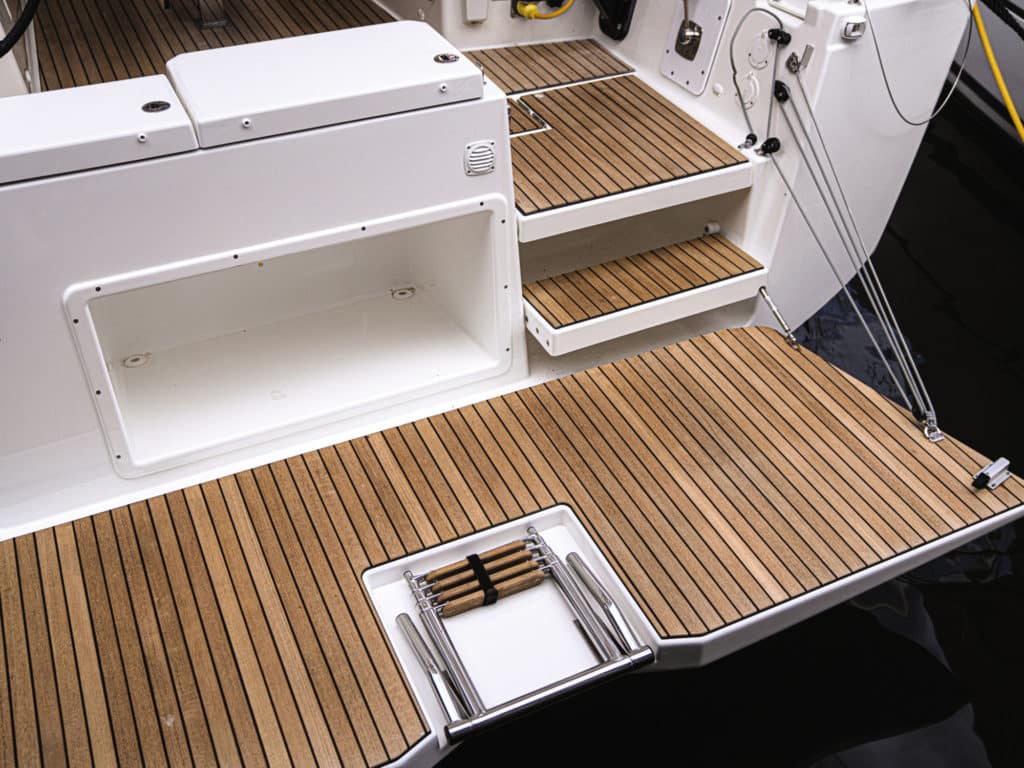
We all know stainless steel isn’t entirely stainless, and that penetrations in the deck are potentially troublesome; allowing moisture to enter a core material, such as end-grain balsa, can have serious consequences. The core and fiberglass skins must be properly bonded and the kerfs not filled with resin. Beginning in the mid-1990s, some builders such as TPI, which built the early Lagoon cruising catamarans, began using structural adhesives, like Plexus, to bond the hull/deck joint rather than using dozens of metal fasteners. These methacrylate resins are now commonly used for this application and others. Klopman says it basically should be considered a permanent bond, that the two parts, in effect, become one. If you think a through-bolted hull/deck joint makes more sense because one could theoretically separate them for repairs, consider how likely that would ever be: not highly.
Fit-and-Finish
Wide transoms spawned an unexpected bonus; besides the possibility of a dinghy “garage” under the cockpit on larger boats, swim platforms are also possible. In more than one BOTY yacht, the aft end of the cockpit rotated down hydraulically to form the swim platform—pretty slick.
Teak decks are still around, despite their spurning for many years by owners who didn’t want the upkeep. In the 1960s and ’70s, they were considered a sign of a classy boat but fell from favor for a variety of reasons: maintenance, weight and threat of damaging the deck core (the bung sealant wears out and water travels down the fastener through the top fiberglass skin into the core). Specialty companies that supply builders, like Teakdecking Systems in Florida, use epoxy resin to bond their product to decks rather than metal fasteners. And the BOTY judges saw several synthetic faux-teak products that are difficult to distinguish from real teak—the Esthec installed on the Bavaria C50 being one example.
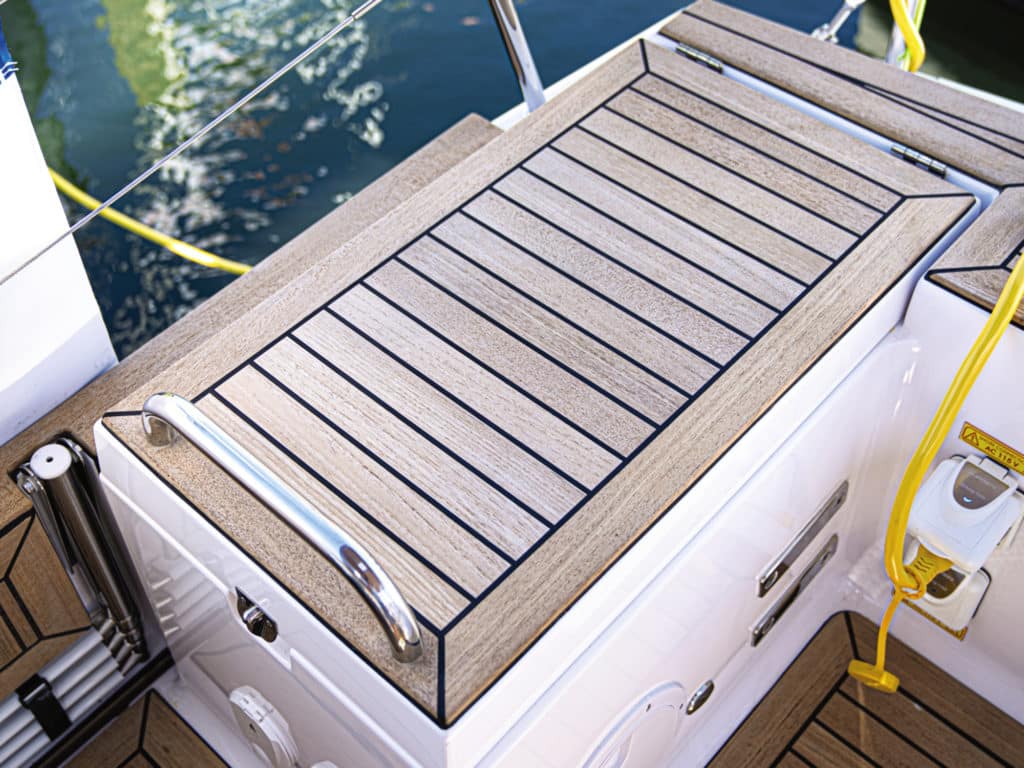
LPG tanks no longer have to be strapped to a stanchion or mounted in a deck box because decks now often incorporate molded lockers specifically designed for one or two tanks of a given size. To meet ABYC standards, they drain overboard. In tandem with these lockers, some boats also have placements or mounts for barbecues that are located out of the wind, obviating the common and exposed stern-rail mount.
Low-voltage LED lights are replacing incandescent bulbs in nearly all applications; improvements in technology have increased brightness (lumens), so some even meet requirements for the range of navigation lights. Advances in battery technology translate to longer life, and depending on type, faster charging. And networked digital switching systems for DC-power distribution also are becoming more common.
Last, I was surprised at how many expensive yachts exhibited at Annapolis had nearly the least-expensive toilets one can buy. Considering the grief caused by small joker valves and poorly sealed hand pumps, one would think builders might install systems that incorporate higher-quality parts or vacuum flushing, and eliminate the minimal hosing that famously permeate odors.
Dan Spurr is an author, editor and cruising sailor who has served on the staffs of Cruising World, Practical Sailor and Professional Boatbuilder. His many books include Heart of Glass , a history of fiberglass boatbuilding and boatbuilders .
Other Design Observations
Here are a few other (surprising) items gleaned from several days of walking the docks and sailing the latest models:
- Multihulls have gained acceptance, though many production models are aimed more at the charter trade than private ownership for solitary cruising. You’d have to have been into boats back in the ’60s and ’70s to remember how skeptical and alarmist the sailing establishment was of two- and three-hull boats: “They’ll capsize and then you’ll drown.” That myth has been roundly debunked. Back then, the only fiberglass-production multihulls were from Europe, many from Prout, which exported a few to the US. There are still plenty of European builders, particularly from France, but South Africa is now a major player in the catamaran market.
- The French builders now own the world market, which of course includes the US. Other than Catalina, few US builders are making a similar impact. In terms of volume, Groupe Beneteau is the largest builder in the world, and they’ve expanded way beyond sailboats into powerboats, runabouts and trawlers.
- Prices seem to have outpaced inflation, perhaps because, like with automobiles, where everyone wants air conditioning, electric windows and automatic transmissions, today’s boats incorporate as standard equipment items that used to be optional. Think hot- and cold-pressure water, pedestal-wheel steering, and full suites of sailing instruments and autopilots.
- More: design , print may 2020 , Sailboats
- More Sailboats

Sailboat Review: Tartan 455

Meet the Bali 5.8

Celebrating a Classic

New to the Fleet: Italia Yachts 12.98
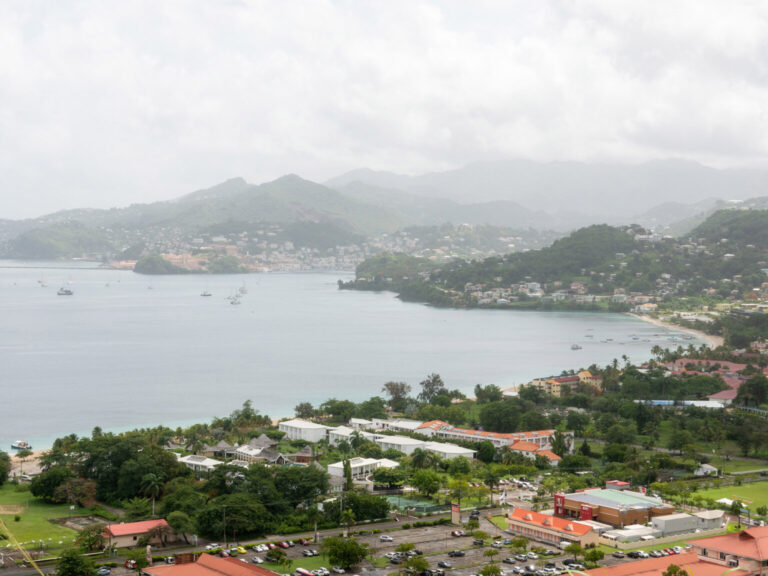
Grenadines Boat Hijacking Suspects Charged with Murder
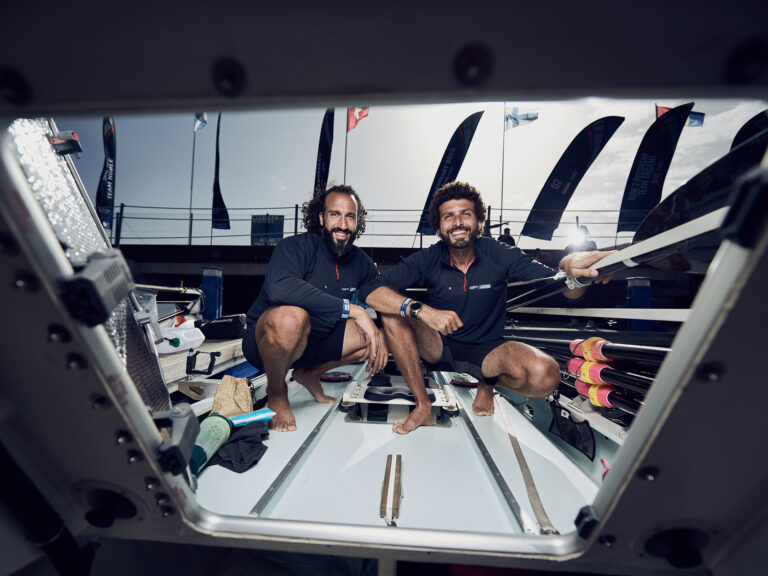
13 Hours in a Life Raft
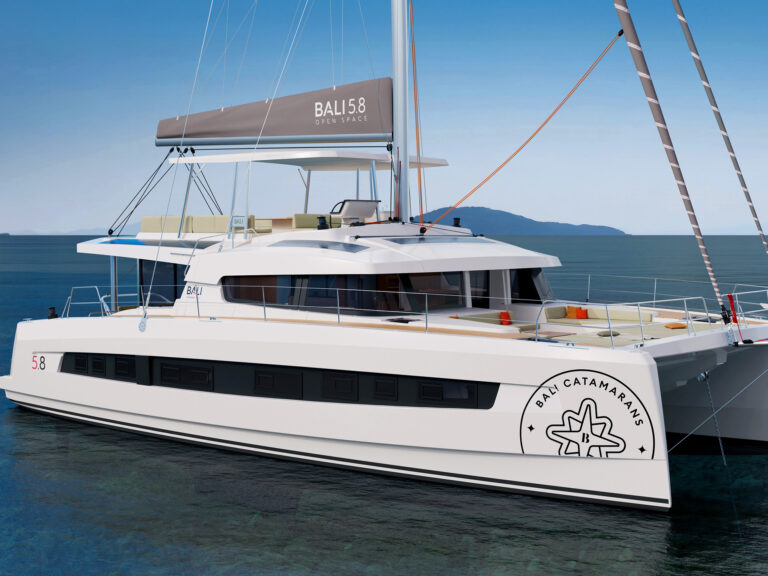
- Digital Edition
- Customer Service
- Privacy Policy
- Terms of Use
- Email Newsletters
- Cruising World
- Florida Travel + Life
- Sailing World
- Salt Water Sportsman
- Sport Fishing
- Wakeboarding
GET A FREE QUOTE TODAY - CALL US - PHONE: 01371 875214
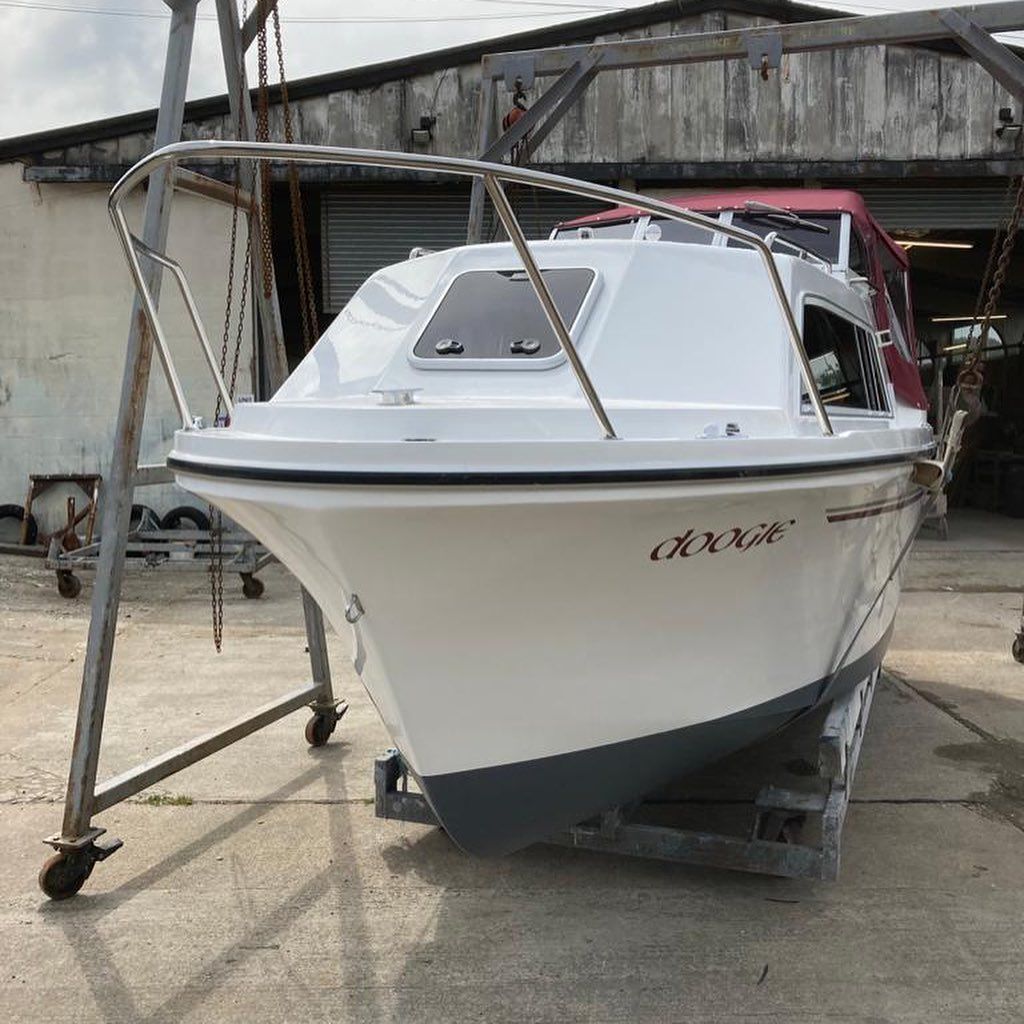
Slide title

Viking 275
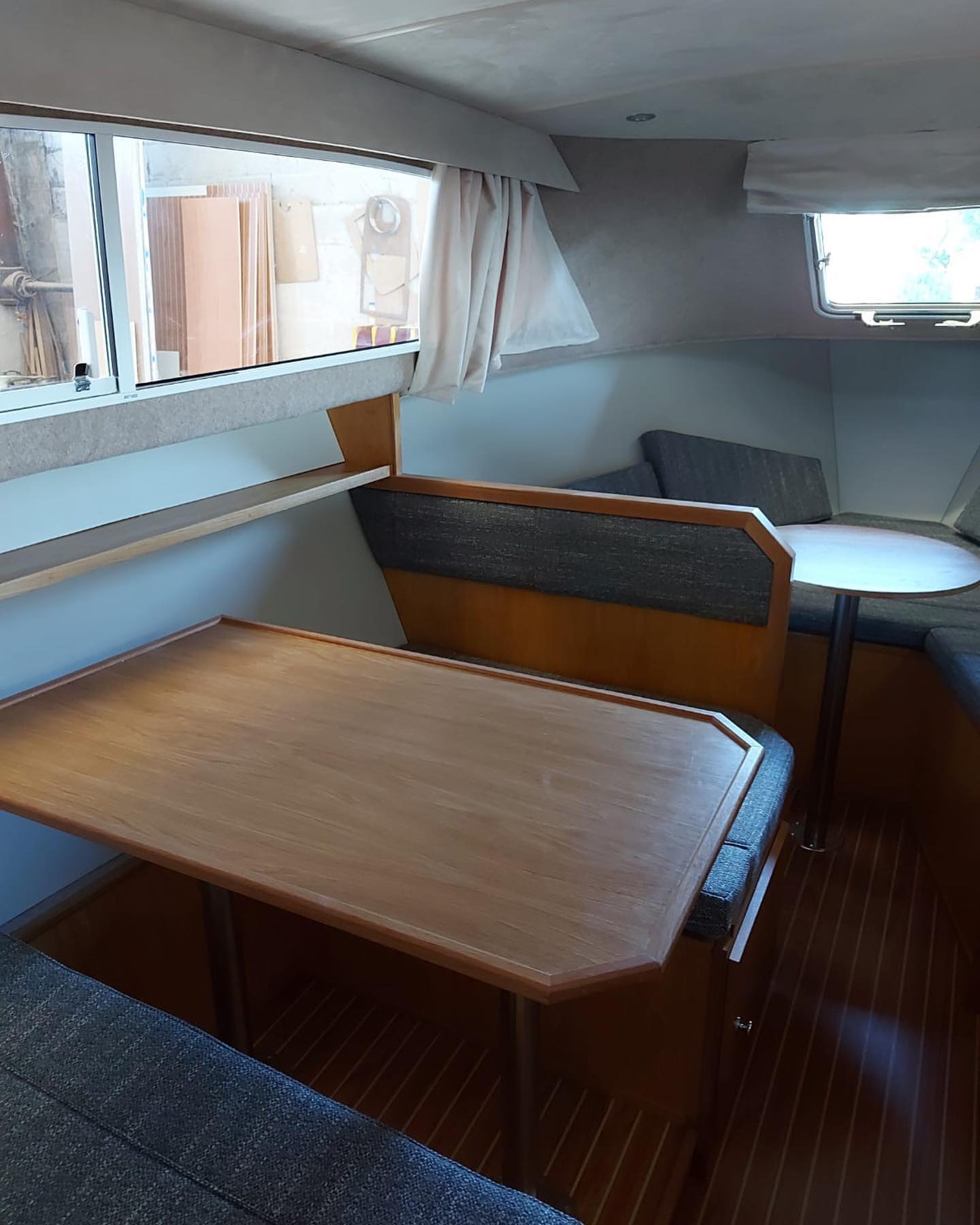
NEW Viking 300
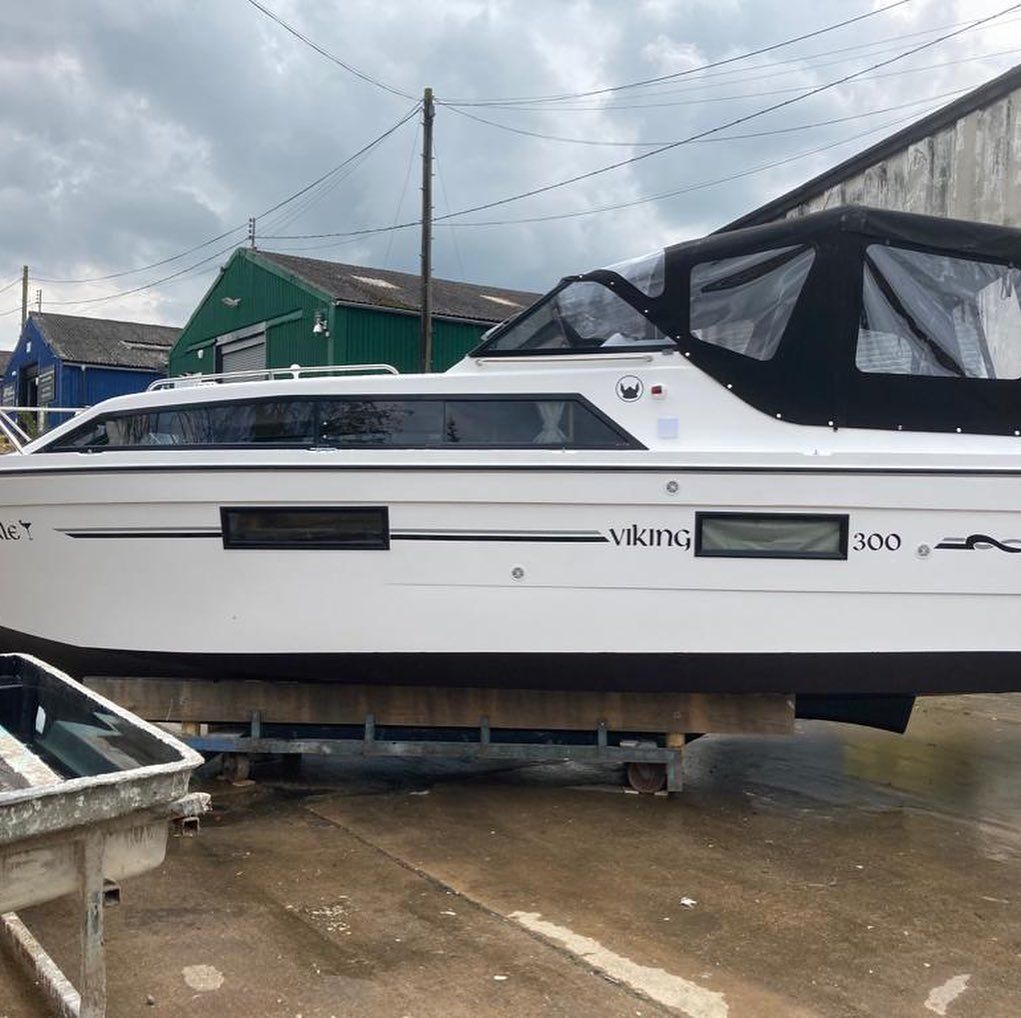
WHERE TO FIND US
Tel: +44 1371 875214 mob: +44 1371 875214 e: [email protected].

5 Best Liveaboard Bluewater Sailboats

Last Updated by
Daniel Wade
December 28, 2023
Liveaboard bluewater sailboats are both comfortable to live on and capable of making long, offshore ocean voyages.
The best liveaboard bluewater sailboats must strike a balance between comfort and seakeeping abilities. These boats are generally heavy and stable and roomy enough to spend time in. They must also include the necessary hardware to make cooking, sleeping, and bathing possible in choppy conditions.
Table of contents
Bluewater Liveaboard Sailboat Design
What makes a good bluewater liveaboard sailboat , and how is it different from a coastal cruiser? There are a few aspects of purpose-built bluewater sailboats that make them different from most production vessels. The first and (possibly) most important is the hull design.
The classic bluewater sailboat hull shape features a long, deep, full keel. The keel acts as a hydroplane and keeps the boat stable on course in all sea conditions. Deep keel sailboats aren't the only kind of bluewater-capable vessels, but they're a tried and tested design.
Other vessels gain stability from having a wide beam. Beamy sailboats are far more comfortable in rolling seas, as they tend to buffett and pitch much less than leaner, narrow boats. Most ideal liveaboard bluewater sailboats balance length and beam carefully to make the most of the space and hull shape.
Space is another important quality to consider when choosing the best bluewater liveaboard sailboat. Interior space comes first, as living quarters are a key element of comfort.
Cockpit space should also be considered, especially if more than one person comes aboard. Most liveaboard bluewater sailboats sacrifice cockpit space for cabin space.
A comfortable liveaboard sailboat should include several amenities, including a head (toilet), a shower, two sinks, a galley with a stove, an icebox, a place to eat, and a place to sleep. Ideally, the dining area is separate from the primary sleeping area.
A separate chart table is ideal as well because it keeps food and clutter away from important navigational equipment. A chart table is less important on liveaboard sailboats that spend the majority of their time docked. That said, the chart table functions well as a spot for a microwave, toaster oven, or TV when you're not underway.
A separate forward V-berth, known as a master cabin, is a big plus on liveaboard boats. Separating the sleeping area from the rest of the cabin can increase comfort and coziness.
However, on a bluewater sailboat, a side berth near the hatch is essential as well. This is because you may need to quickly take control of the vessel after waking up, and it's best to sleep close to the helm.
Power and Water
Power and water shouldn't be overlooked when choosing a bluewater liveaboard. Many liveaboards spend most of their time docked and hooked up to shore power, water, and sewage. But bluewater liveaboards are designed for cruising, which means everything must be self-contained.
The best bluewater sailboats have sufficient freshwater storage tanks for several weeks on the water. Some have desalination (water maker) machines, which require electricity to run.
Solar panels are an excellent option for power generation, and they can be installed on almost any sailboat.
But all bluewater sailboats should have battery banks and a gasoline or diesel generator built into the system. On many vessels, the inboard engine also functions as a generator.
Safety is an essential factor to consider when choosing a cruising sailboat , especially if it doubles as your primary residence. Basic safety equipment such as bilge pumps and radios should be maintained and tested regularly. Backups and spare parts should also be kept aboard.
Other safety features, such as watertight hatches, can keep your cabin safe and dry during inclement weather. Self-draining cockpits are helpful when sailing offshore, as spray and waves drain from the exposed cockpit without the use of electric or mechanical pumps. If the drain ports are kept clean, no bailing is ever necessary.
Radar is another useful safety feature that, while not mandatory, can keep you in-the-know and alert you to the presence of nearby ships. Radar is especially useful at night, as the automatic alarms can wake you whenever a potential obstacle appears nearby.
Bluewater Sailboats for Living Aboard and Cruising
Living aboard a sailboat is one of the most interesting and rewarding lifestyles available today. It's even more alluring when you can sail your vessel across oceans, which is what bluewater sailboats are designed to do.
A liveaboard cruising sailboat combines comfort, seakeeping ability, and ease of handling in a compact and thoughtfully-designed package. Here are the best liveaboard sailboats for bluewater cruising.
1. Pacific Seacraft Flicka 20
{{boat-info="/boats/pacific-seacraft-flicka-20"}}
The Flicka 20 is the smallest and most interesting sailboat on our list. At only 20 feet overall in length, the interior accommodations of this vessel are spartan at best and suitable for minimalist living.
What makes the Flicka 20 stand out is its exceptional bluewater performance. This sailboat is truly an ultracompact pocket cruiser. With a full ballast keel, self-draining cockpit, and wide beam, the Flicka 20 is more capable offshore than some boats almost twice its size.
This sailboat has the profile of a traditional keel cruiser. From a distance, it would be easy to mistake for a much larger vessel. Its hull shape, manageable Bermuda rig, and small size make it a perfect starter sailboat for single handed offshore cruising.
Inside, you have (almost) everything you need to live comfortably, albeit in a minimalist way. The cabin features standing headroom throughout, which is highly unusual for a 20-foot sailboat. On the port side, you're greeted with a small but functional galley. On the starboard side, there's a small head with a toilet and a shower.
The Flicka 20 displaces a hardy 5,500 lbs. Due to its large keel, there's no centerboard trunk to obstruct interior space. A V-berth upfront makes up the sleeping accommodations, and some models feature settees on both sides with a pop-up dining and chart table in between.
The Pacific Seacraft Flicka 20 has achieved somewhat of a cult status amongst bluewater sailboat enthusiasts. Only about 400 were built, so purchasing a Flicka 20 is somewhat of a rare and expensive proposition. That said, the benefits of owning a 20-foot bluewater liveaboard sailboat are hard to beat.
Cheap slip fees, low maintenance costs, and simplicity are the major selling points of this vessel. It's trailerable behind most heavy-duty pickup trucks and technically small enough to store on the street or in a driveway.
2. Pacific Seacraft Allegra 24
{{boat-info="/boats/pacific-seacraft-allegra-24"}}
If the Flicka 20 is too small for your taste, try the Pacific Seacraft Allegra 24. It follows the same design principles of the Flicka 20, but with four feet of additional space for cabin amenities and seaworthiness.
Four feet may not sound like a lot, but it makes a world of difference on a sailboat. The additional space on the Allegra 24 adds room to the head, extends the port and starboard settees, and increases the size of the galley.
If you like the idea of a small, semi-trailerable offshore sailboat with liveaboard amenities, you'll love the Allegra 24. This stout sailboat has almost miraculous handling and seakeeping qualities while retaining the benefits of small overall size.
With the Allegra 24, you'll be able to make virtually any offshore passage and save on slip fees, maintenance costs, and overall labor. This vessel is easy to sail single handed and large enough for a minimalistic couple to live, eat, and sleep comfortably.
The Pacific Seacraft Allegra 24 is not ideal for people who need space for pets, children, or guests, as the interior is quite small when compared to other sailboats. That said, there's enough room for an occasional passenger, and the cockpit is comfortable enough for four adults to sit and interact.
3. O'Day 28
{{boat-info="/boats/oday-28"}}
The O'Day 28 is a popular sailboat that makes a great liveaboard cruising platform. This affordable vessel was produced between 1978 and 1986, and over 500 examples were produced over the years.
All in all, the O'Day 28 is a stout cruising sailboat that's suitable for offshore and coastal sailing. It features a raked stern and hidden rudder, and a helm that's similar to what you'd find on much larger boats.
The O'Day has a large fuel tank for its inboard engine and an even larger 25-gallon freshwater capacity, which is excellent for offshore cruising. Additional tanks can be added in storage spaces, making the O'Day 28 suitable for long voyages.
The cabin of the O'Day 28 is spacious and includes everything you'd need to live aboard comfortably, along with plenty of storage space throughout. The wide beam of the O'Day 28 gives it lots of space, so the cabin doesn't feel cramped for its size.
Two models of the O'Day 28 were built; one featured a swing keel, and the other had a fixed swing keel. The swing keel model is ideal for coastal cruising and shallow-water sailing, while the fixed keel O'Day 28 is more suited for bluewater cruising.
That said, both keel variants make fine offshore sailboats. The cabin of the O'Day 28 features a large galley with a stove and icebox, two large settee berths, a large center table ahead, and a V-berth forward. The head serves as a separator to the forward cabin, giving the V-berth an extra layer of privacy.
4. William Atkin "Eric" 32
{{boat-info="/boats/atkin-co-eric-32"}}
"Eric," designed in the 1920s by famous marine architect William Atkin, is a radical departure from typical modern liveaboard sailboats. However, as a bluewater liveaboard sailboat, this vessel likely outshines all the others on this list in almost every conceivable way.
Eric is a 32-foot traditional wooden ketch. This planked full- keel sailboat displaces over 19,000 lbs and has a draft of about five feet. The basic design of the hull is based on early Norweigian fishing boats, which were known for their resilience in rough North Sea storms.
Eric is a traditional gaff-rigged vessel with two short masts and a long bowsprit. Though complex to rig, it sails beautifully in all weather conditions. One of the earliest examples built survived a hurricane offshore in the 1930s, and subsequent models have completed numerous long-range ocean voyages.
Eric is a purpose-built long-range ocean cruiser. Interior accommodations are spacious and designed for comfort and utility. Unlike most sailboats of the time, Eric features a full head with shower, a 'master cabin' style V-berth forward, a full galley with an icebox, and standing headroom throughout.
William Atkin's Eric is, by all definitions, an ocean-crossing sailboat designed to take between one and four adults just about as far as they want to go. It has all the qualities of an oceangoing sailboat in a compact package, along with excellent seakeeping characteristics.
The primary drawback of this 32-foot Atkin sailboat is maintenance. Most of these hulls were constructed using traditional oak planking, which lasts forever if taken care of but requires skilled maintenance. The planks are caulked using cotton wadding, and they'll need recaulking if the boat stays out of the water for too long and "dries up."
If you're looking for a beautiful and historic liveaboard sailboat with serious offshore cruising capabilities, consider an Atkin Eric 32. Although somewhat rare, examples of this design occasionally pop up for sale on the used market.
5. Pearson 35
{{boat-info="/boats/oday-28"}}, {{boat-info="/boats/pearson-35"}}
The Pearson 35 crosses the rubicon into the 'big boat' category, as it has everything you'd expect of a large oceangoing sailboat. The vessel also has a unique displacement keel with an additional swing keel at the base.
The Pearson 35 is a roomy sailboat with excellent seakeeping abilities and a large sail plan. It's a typical Bermuda-rigged sloop with a tall mast and the usual sheet and halyard arrangement. As a result, it's fun to sail and easy to handle. It's also a fast boat, making it ideal for longer voyages.
The swing keel certainly doesn't make the Pearson 35 a shoal-draft sailboat. It has a modified full keel which (with the swing keel retracted) draws 3 feet 9 inches. With the additional swing keel down, the draft of the Pearson 35 increases to over 7 feet.
The Pearson 35 is a heavy boat with good sea keeping abilities. It was introduced in 1968, and over 500 units were produced. That makes it one of the more popular sailboats in its class, and plenty of Pearson 35s are still sailing around the United States.
Down below in the cabin, the Pearson 35 is roomy and comfortable. It features a full galley, an enclosed head with a shower and sink, and several berthing areas, including a forward V-berth. Plenty of storage is available throughout the cabin, making the Pearson 35 an excellent choice for living aboard.
There's something empowering about piloting a 35-foot sailboat through rough weather. The size of the boat provides both safety and a sense of security, which can help you keep a clear head during stressful situations at sea. The vessel is beamy as well, making it less likely to heel aggressively and increasing roll comfort in dicey seas.
Overall, the Pearson 35 is an excellent choice for a liveaboard bluewater sailboat. It's a large boat in comparison to the others on this list, and it's known for easy handling and excellent windward performance. The Pearson 35 is a common sailboat that's widely available on the used market.
Related Articles
I've personally had thousands of questions about sailing and sailboats over the years. As I learn and experience sailing, and the community, I share the answers that work and make sense to me, here on Life of Sailing.
by this author
Best Sailboats
Most Recent

What Does "Sailing By The Lee" Mean?
October 3, 2023

The Best Sailing Schools And Programs: Reviews & Ratings
September 26, 2023
Important Legal Info
Lifeofsailing.com is a participant in the Amazon Services LLC Associates Program, an affiliate advertising program designed to provide a means for sites to earn advertising fees by advertising and linking to Amazon. This site also participates in other affiliate programs and is compensated for referring traffic and business to these companies.
Similar Posts

Affordable Sailboats You Can Build at Home
September 13, 2023

Best Small Sailboats With Standing Headroom

Best Bluewater Sailboats Under $50K
Popular posts.

Best Liveaboard Catamaran Sailboats

Can a Novice Sail Around the World?
Elizabeth O'Malley
June 15, 2022

4 Best Electric Outboard Motors

How Long Did It Take The Vikings To Sail To England?


10 Best Sailboat Brands (And Why)
December 20, 2023

7 Best Places To Liveaboard A Sailboat
Get the best sailing content.
Top Rated Posts
Lifeofsailing.com is a participant in the Amazon Services LLC Associates Program, an affiliate advertising program designed to provide a means for sites to earn advertising fees by advertising and linking to Amazon. This site also participates in other affiliate programs and is compensated for referring traffic and business to these companies. (866) 342-SAIL
© 2024 Life of Sailing Email: [email protected] Address: 11816 Inwood Rd #3024 Dallas, TX 75244 Disclaimer Privacy Policy
You are using an outdated browser. Please upgrade your browser to improve your experience.
- Sell my boat
Aquavista Support Centre Sawley, Waterside & Marinas, Long Eaton, Nottinghamshire, NG10 3AE
Hydra - £89,950
Hydra is a 60ft long x 10ft wide, wide-beam built by Viking Canal Boats in 2011. She is fitted with a Beta Marine 60HP inboard diesel engine, has 4 berths and a bow thruster.
Hydra is an exceptional cruiser stern wide-beam and benefits from spray foam insulation, fixed double Queen size bed and double sofa bed, quadrant shower cubicle and new cratch and pram covers. The engine was serviced in June 2021. Viewing is highly recommended!!
BSC expires: - Oct 2027
Last blacking: - June 2022
Hull & superstructure: - Steel 10 / 6 / 5 / 4
Stern type: - Cruiser
Engine: - Beta Marine 60HP
Bow thruster: - Electric
Electrics: - Shore power - Victron Multiplus 3000w inverter - Charger
Batteries: - 1 x engine start - 5 x domestic - 2 x bow thruster
Galley equipment: -Thetford Caprice MK III oven - Hob and grill - Shoreline 12v fridge-freezer - Washing machine - Slimline dishwasher
Water heating: - Engine - Immersion - Central heating boiler
Cabin heating: - Webasto 5.2kw - Solid fuel Morso Squirrel Stove - Radiators
Water capacity: - Approx 200 gallons
Fuel capacity: - Approx 80 gallons
Toilet: - Thetford C260 cassette (3 x spare cassette's)
Fitting out: - Oak Veneer ply
Flooring: - Carpet in bedroom - Cushion floor in bathroom - Laminate in saloon and galley
Headroom: - 6ft 7in
Please note: this is not a survey report and all pre-owned boats are sold without warranty.
The information provided is based on a superficial inspection carried out by us and information provided by the vendor. No guarantee is given or implied regarding the specification, but descriptions are given in good faith as could be ascertained at the time of inspection. Aquavista takes no responsibility for the accuracy of this information and recommend the use of a marine surveyor to establish the condition of the vessel.
LET'S GET STARTED
Arrange a viewing
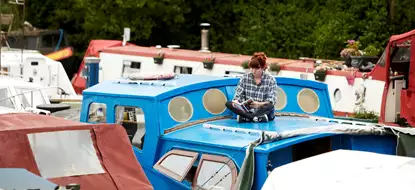
Sign up for our newsletter
Receive the latest news from Aquavista, and let us help you discover the life.
Narrow beam canal boats
Widebeam house boats.
- Customer stories
- News & updates
BUILD A BOAT AS UNIQUE AS YOU
The UK’s leading supplier of luxury widebeam and narrow boats. As our name suggests, each vessel we build is carefully tailored to your every need, packed with practicality, and oozing with style. Together, we can bring your dream boat to life.

Meet the team behind the magic.
With decades of experience in boatbuilding and construction, our team of specialists are on hand to guide you through every step of the project.
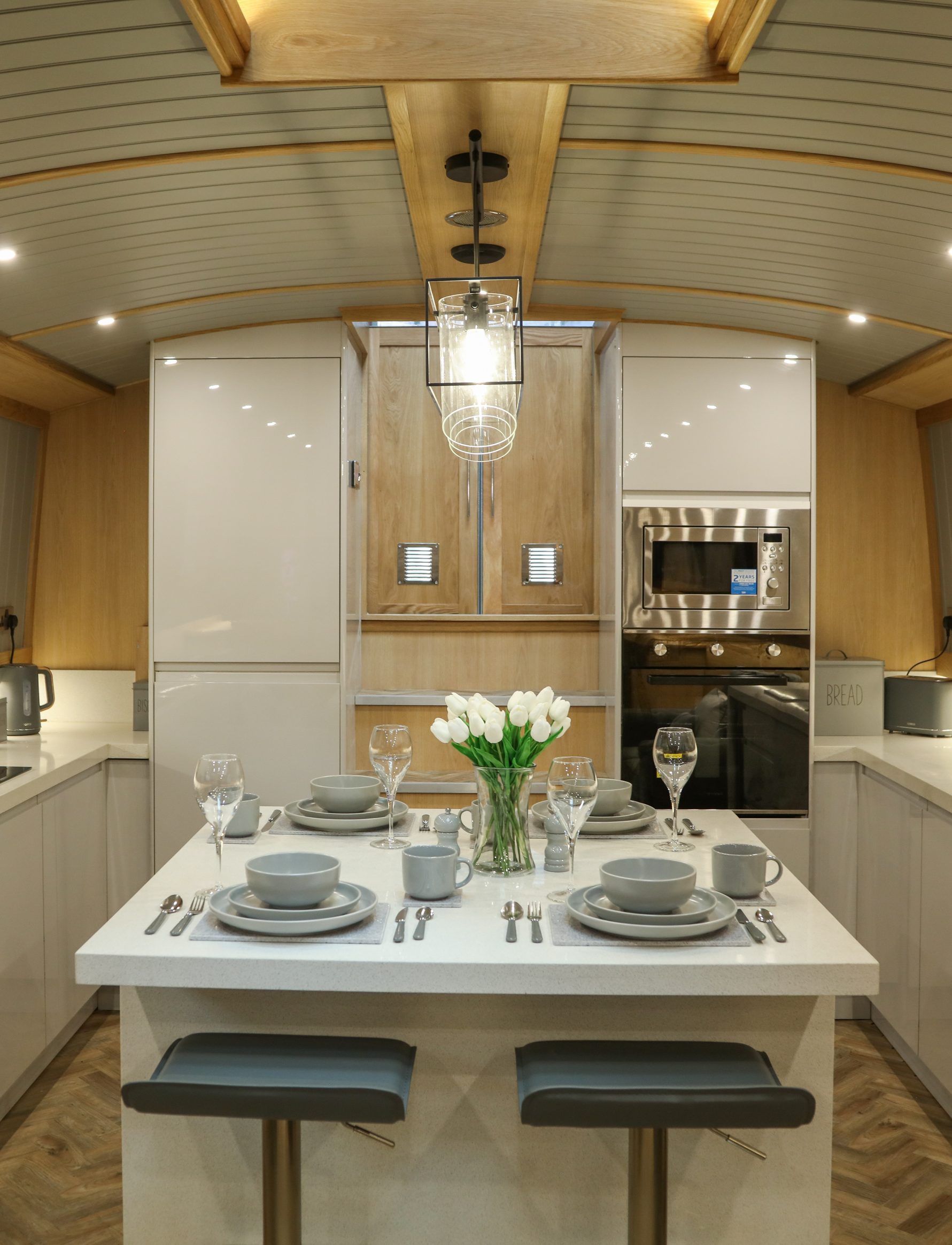
Designed around your lifestyle.
Whilst no two boats we build are ever the same, the type of vessel you choose will depend on how you plan to enjoy your new home.
Have you been itching to go full nomad and explore the length of the country? Or would you prefer to surround yourself with all of your favourite creature comforts and leave ample room for entertaining?
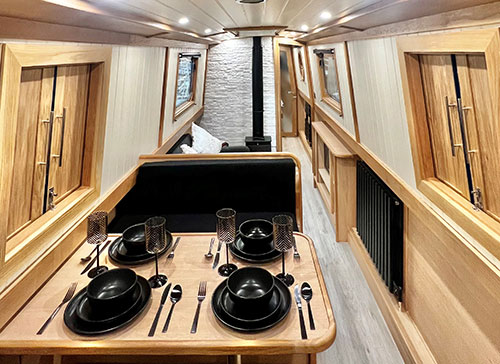
Constantly cruise on every UK waterway with our traditional fuel and energy efficient narrowboats.
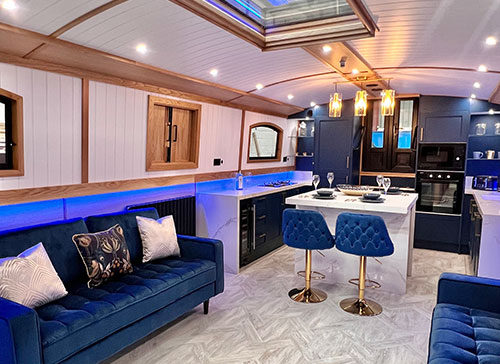
Escape the hustle and bustle of the city and create your dream home on the water for a fraction of the cost.
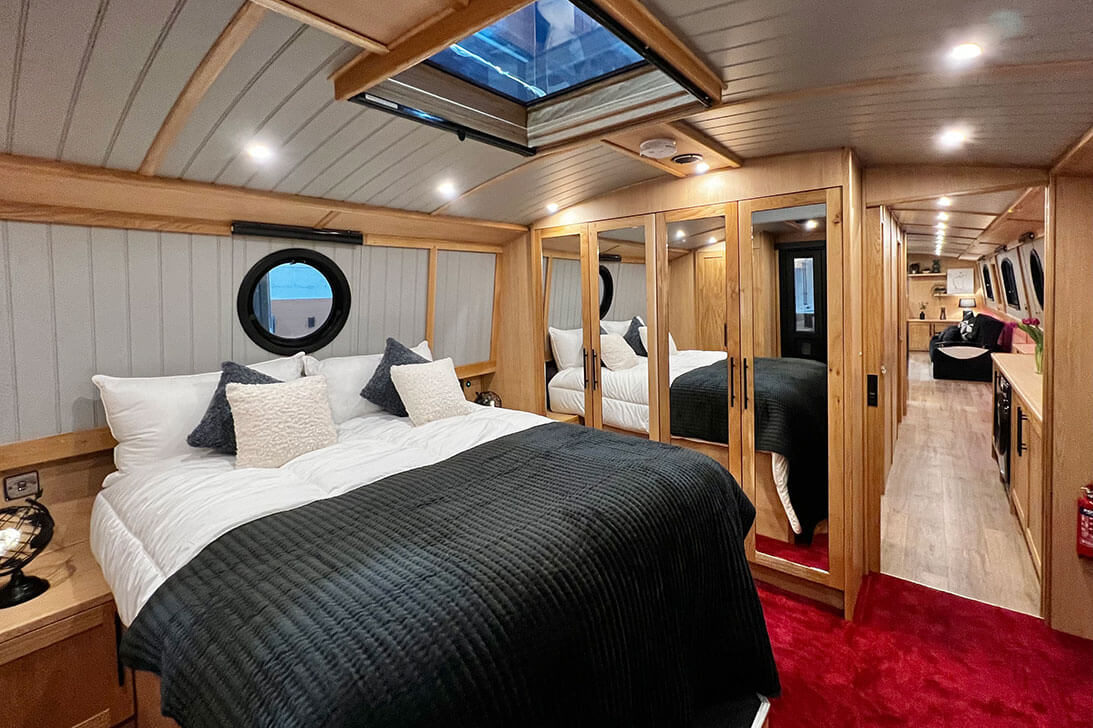
“We chose Bespoke Boat Co. to build our widebeam over others because of their professional attitude quality of service. They have fully lived up to their word and build us a stunning widebeam with unprecedented attention to detail. I’d 100% recommend them.” Darren & Ria, Purple Haze
Together We’ll Make a Masterpiece
It starts with a vision. We’re here to discuss your project, whenever you’re ready.
13 Best Liveaboard Sailboats (under 30 & 50 ft)
Choosing a boat to live on is a big deal — something you definitely want to get right. There are plenty of options to pick from, which can make the choosing process a bit daunting. So to help you navigate those deep waters (no pun intended), here is an article summarizing the 13 best liveaboard sailboats under 30 and 50 feet.
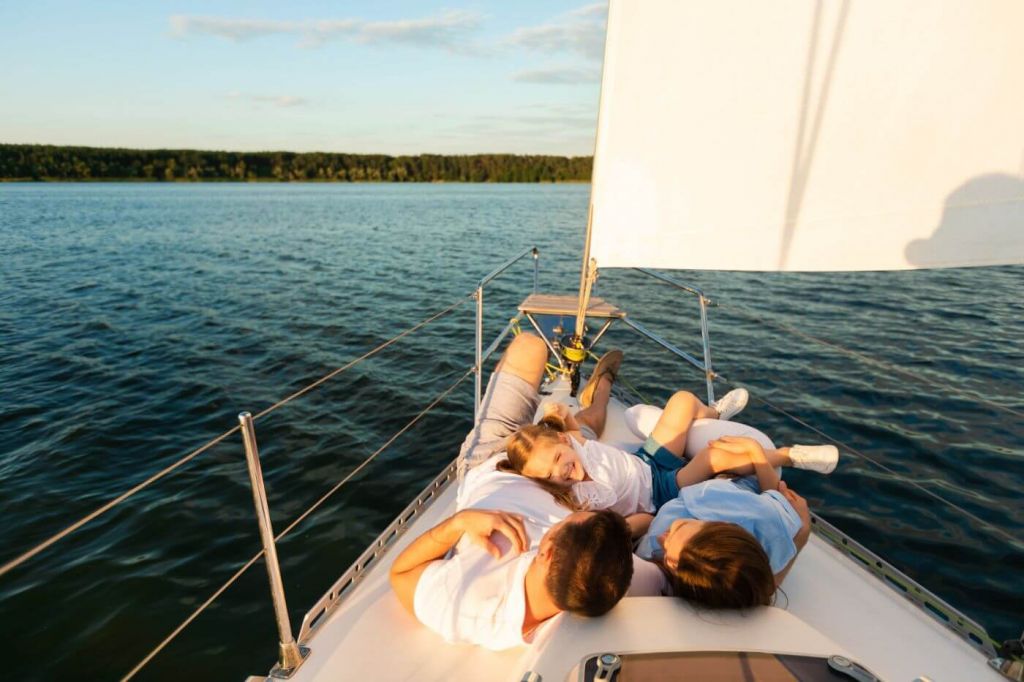
So what are the 13 best liveaboard sailboats?
Catalina 30, pacific seacraft flicka 20, nonsuch ultra 30, aventura 34, island packet 35, peterson 44, prout snowgoose 37, gulfstar 44, beneteau oceanis 50.
Beautiful lineup, isn't it? Let me explain what makes these so special.
Picking the Right One Matters
Picking a liveaboard sailboat belongs among those kinds of decisions that require months, if not years of research and testing.
It is not like choosing a car - those are more or less the same, and although they vary widely in terms of comfort, feeling, and performance, rarely you would encounter one that wouldn't get you from point A to B reasonably.
The same goes for a house or an apartment. Regardless of if you get a 200 square foot condo or a 30,000 square feet mansion, it will most of the time provide a warm shelter with a shower and a kitchen and a bed, fulfilling its basic functions.
But this is only the case because there is extensive infrastructure in place helping cars and houses. A car can only get you from A to B thanks to roads. A house can only have a shower and a kitchen if it is connected to a grid.
But on a boat, you are on your own.
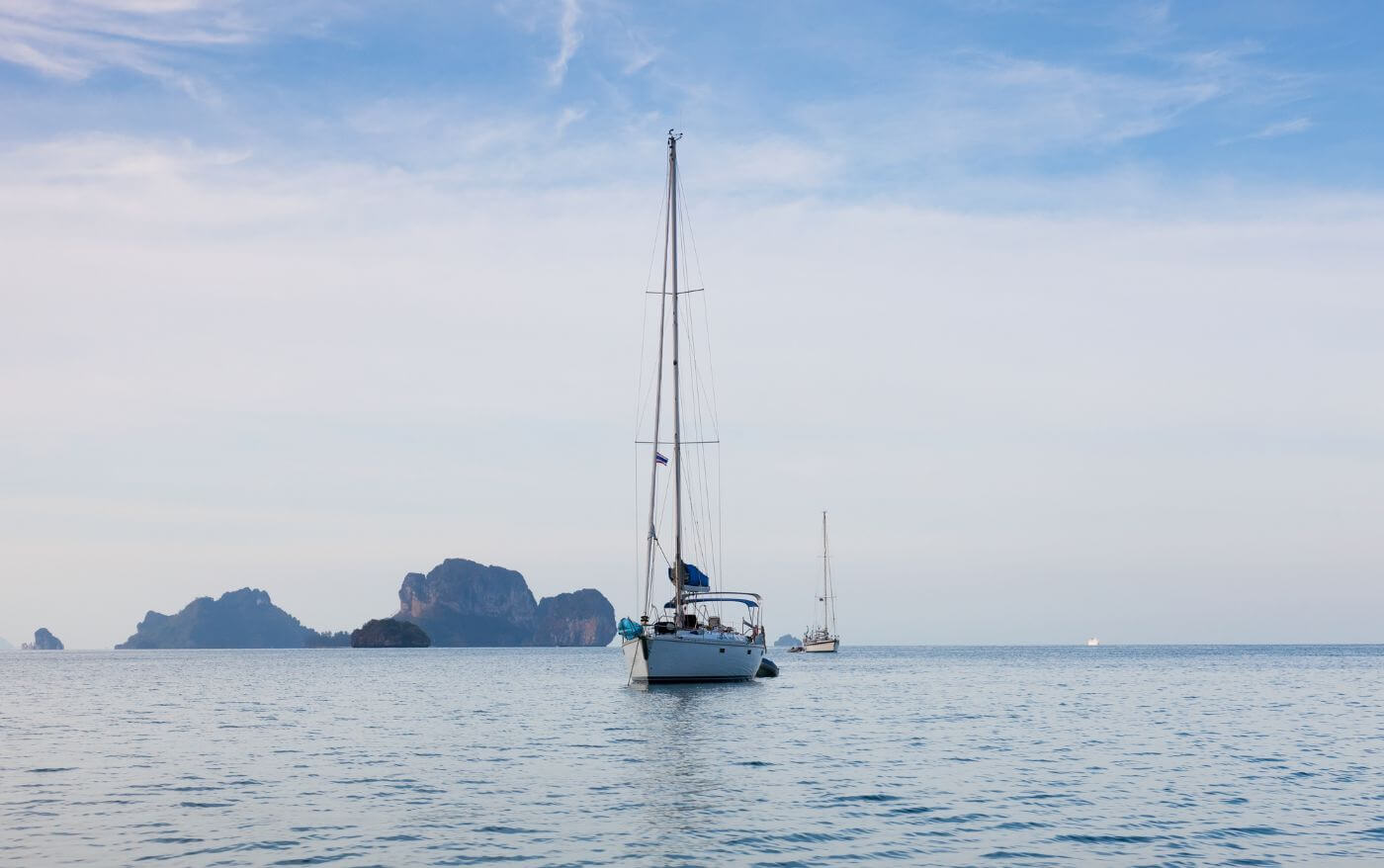
The sea doesn't adjust its waves for your comfort. If something breaks, there is usually not a repair shop nearby. You aren't always connected to water or electricity. And if you don't like what you see around yourself, it's not like you can just leave.
So a liveaboard boat needs to provide what a house does, what a vehicle does, and more, plus it needs to provide this regardless of if you are docked in a marina or in the middle of the Pacific Ocean. That is a lot to ask, especially if we are talking about boats around 30 or 50 feet.
Fortunately, every single boat on this list is an all-star that ticks all the right boxes. Let's see why.
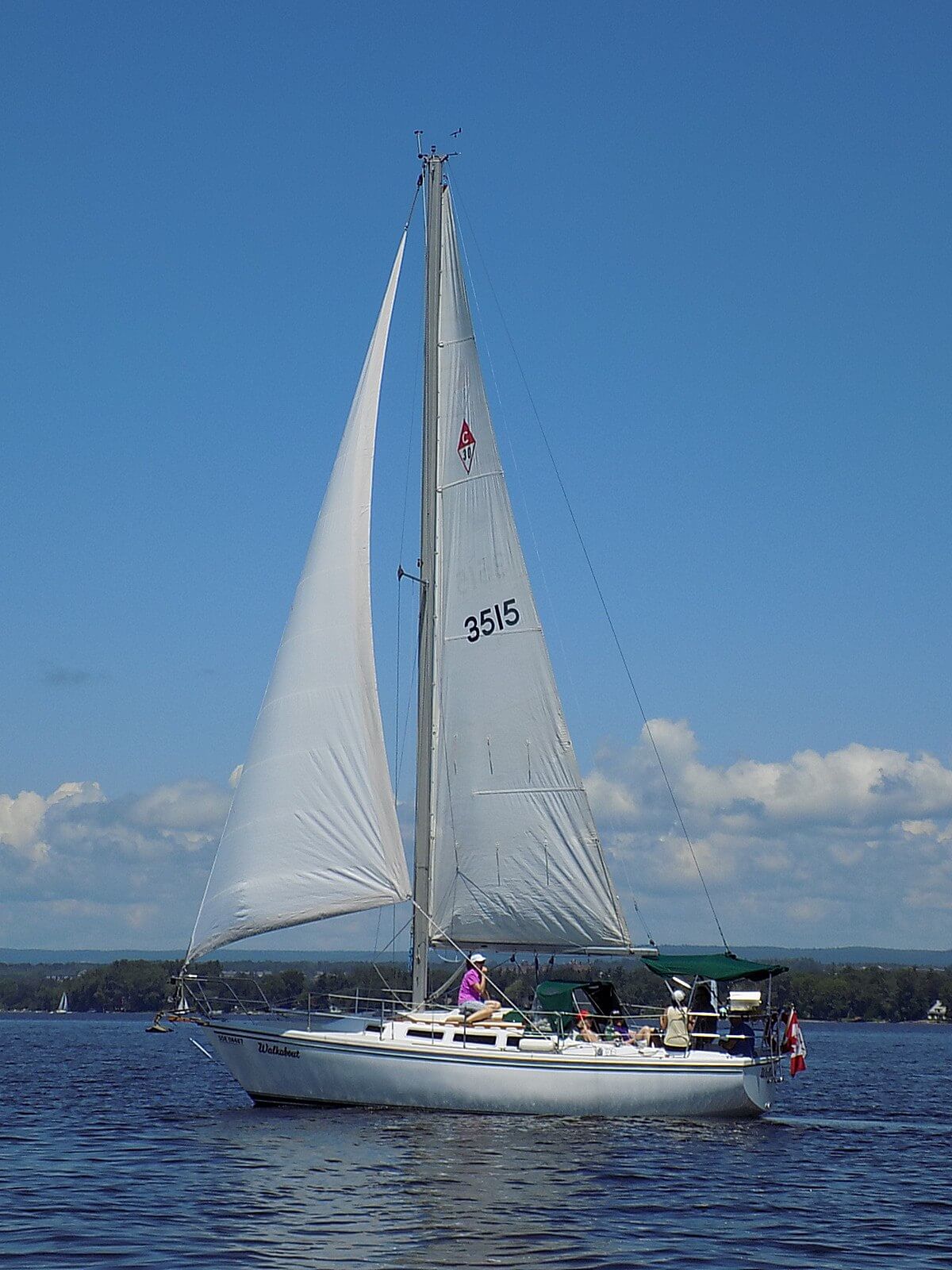
I know, I hear you, it isn't exciting enough as it doesn't perform that well. Sure. But we are talking about a boat that is supposed to be a house too. So why is it on the list?
This boat has been in production since 1975, which means that it has been extraordinarily well-refined according to the suggestions of thousands of owners. And this manufacturer is known for listening to the sailors' feedback. It is a very popular model, so finding spare parts for it will always be easy. Its famous well thought through the salon, and cabin layout is generous and spacious, so Catalinas are comfortable boats to live on. Plus, the boat has quite a wide beam, great ballast/displacement ratio as well as low sail area/displacement ratio, making it a stiff boat under sail, which adds to stability and comfort.
Good condition MkIII Catalinas can be found for about $35,000, but given the volume of these on the market, you can find a usable one even for around $15,000.
This one is a hero. I'd be hesitant to call such a small boat a comfortable liveaboard if it wasn't for this model. For its size, the interior is very spacious. It is also made for comfort since it seems to be inspired by the aforementioned Catalina 30. In fact, after reading some reviews, I am confident in saying that you will not find a significantly more comfortable 27 footer out there.
It also has a talent very uncommon for liveaboard boats - you can put it on a trailer, which can make your life easier when it comes to certain trips. But most importantly, it is a beauty. Just look at it.
Pricing this boat is a tricky task. You can buy nearly new ones (2015) for around $140,000, but even for $50,000, you can stumble upon models from both the 80s and the 2000s. This means the condition is a big factor, and you gotta inspect your choice well. The good news is that whatever your price in that range, you will find a boat for that money. The bad news is that the cheaper you go, the more effort will the potential repairs take.
I thought the Nor'Sea 27 is gonna be it, but let's push the size limit even more with the 20 foot Flicka, this tiny, towable, but seaworthy beast that accomplished several circumnavigations. Upon entering, you will be amazed at how spacious and equipped with amenities the interior is. Its designer lived on this boat with his partner (who too was a naval architect) for years and cruised all around the world - and what a proof of confidence in his own design that is.
Truth be told, there is a lack of deck space, but underneath it has the comfort and size of a boat a few meters larger, a space you can comfortably live in. Due to its size, it is easy to operate, tow, and sails better than what you would expect from a boat this length.
This boat is incredibly charming, and so its owners rarely sell it. In fact, it has amassed quite a following since it was designed into existence. So expect to spend quite some time searching for one for sale. Once you do find one, it will cost you around $30,000 - $40,000.
This one's a weird one. But because of it, a very spacious one. It is structured as a catboat, that is, with the mast being all the way on the front of the boat, which makes for impressive space below the deck. It has all the necessary amenities, including a shower, so for the liveaboard lifestyle, this boat definitely deserves to make this list.
The single sail catboat design also means it is easy to handle single-handed, which makes for great solitary passages.
Expect to pay around $40,000 to $60,000 for this one.
Though I am trying to keep this list in lower price ranges, I have to put this one in. If you don't mind the price tag of around $170,000, this boat is marketed as the currently cheapest liveaboard catamaran. As previously mentioned, cats offer the most in terms of space, and this model is a brand new one. Thus when it comes to service troubles and costs, you wouldn't pay much. The look is modern, relatively minimalistic and sleek, so for those of you who would like to give the liveaboard lifestyle a go but get cold feet upon seeing boats from the 80s, this is a way to make sure things remain stylish.
The modernity, space, and attention to practicality when it comes to using this as your home, make this a great entry-level liveaboard choice.
Again, this is no performance vehicle. Rather it focuses on the usual cruiser aspects - space, stability, sturdiness, and convenience, which makes it an ideal candidate for your choice when looking for a new floating home. Aside from the spacious interior, this boat also has an unusually large cockpit, great for those lunches on the deck.
As if the designers knew this might be used by the liveaboard people, this boat is easy to handle, which means even under sail, you won't have issues focusing on what you came for in the first place - sea living.
This boat can be found on the market for around $75,000 - $100,000.
The great thing about the Hunter 33 is that it was designed as more of a house than a sailboat. The attention to accommodation details is great here; there is plenty of space for sleeping the owners as well as the occasional visitors, it has a fantastic headroom throughout the boat and one of the most spacious and comfortable dining spaces seen on boats this size.
Food preparation and consumption was probably high on the priority list of the makers; the kitchen has an L shape, which adds to the convenience.
The price spread on these is quite large, with the bottom around $55,000 for the 2004 models and the top around $95,000 for the 2013 models.
This one is for those who don't mind sacrificing luxury for space. If in the middle of the ocean, it makes sense that one would want as much of usable space as possible, so if you are okay with the simplicity that will inevitably come with a system like this, you have found your match.
An undeniable advantage of such a design approach is that the storage space is maximized. Long passages with the need for plenty of room for equipment and provisions won't be a problem here. The simplicity of this boat is not just in terms of design, but even the electrics and plumbing. Thus if something breaks, you will have an easier time fixing it.
This being an older model, you can get your hands on one for around $30,000.
Since we are mostly looking at cheaper boats here, most of them aren't new - in fact, they likely have quite a few years behind them. The build quality is thus important. You want to go for builds that will last. Peterson is known for this, so it's gotta be on the list. As far as this list goes, it is quite a large boat. Moreover, it is one that has been built with spaciousness in mind, both when it comes to living spaces and storage.
A neat thing about this boat is its attention to performance. It isn't a racer; rather, it fits in the performance cruiser category, but they haven't made too many speed-related compromises here.
Peterson 44 can usually be found for $80,000 - $100,000.
There needs to be a catamaran on this list - they are, by definition, more spacious than monohulls, providing a large living area, which is, of course, an attractive characteristic for a liveaboard boat. Especially if they have a solid bridge deck, creating yet more square feet of usable space, which Snowgoose has. Unfortunately, they tend to be costly. While it is easy to recommend a bunch of half a million dollar cats, to make this list more within reach of the average sailor, I've found this beauty that you can get for around $100,000.
Aside from the extra space, this model is a true bluewater cruiser, meaning you won't be limited by its abilities when planning your journeys.
Those of you who had the pleasure of sailing this boat know why it needs to be here. It was built for a liveaboard lifestyle. Its wide body makes for one spacious interior which is well ventilated, (a very important aspect) with a beautiful galley and it has a large aft cabin with a huge bed. It was made with comfort, practicality, and convenience in mind.
Not to sound like a salesman, but believe me when I say this boat is a genuine pleasure to be on. If you want the homey feeling, you don't get much closer than this in this size range.
Expect to pay around $80,000 - $100,000 for this one, though some digging around and 'fixing her up' can knock this number down significantly.
This is another easy choice, space being the reason. Not only does it have an extra-large main cabin and salon with a kitchen, many small Parisian apartments could envy, but it is also very generous in terms of storage space. Stocking up for longer crossings will be a pleasure on this one.
Also, it was built as a racer-cruiser, so you won't be making many compromises in terms of performance, as is often the case with comfortable boats.
All of this comes for a price, though. You might be able to find one for around $100,000 if you put some time into your search and won't mind a bit of travel to see it, but otherwise, the average price is around $130,000.
Let's end this list by stretching the ceiling too with this fifty-footer. It was designed as a holiday cruiser, and it is a popular choice among charter companies. The designers know that there are places in Europe where it is very easy to get a sailing license, so many inexperienced people who don't want to give up the comforts of their home end up on these boats. Oceanis 50 is thus comfortable, spacious, easy to sail, and the attention to accommodation details, amenities, and practicality, is very high.
As such, it is designed to house whole families, so if you live there as a couple, you will have a floating house for yourself, and if kids come, no need to buy a new boat. Even on the deck, this boat is designed for pleasure cruises, so as far as that goes, you will be taken care of. As far as their seaworthiness goes, some consider Beneteau an entry-level holiday brand, and some models are indeed more designed for coastal hopping than large crossings. But that can be fixed with some proper fitting.
If you fancy a new one, you will find yourself paying above the $500,000 mark, but older models start a bit above $100,000. Which is something a person who just sold all their possessions to escape to the sea is more likely to have. Just be a bit careful with boats sold by charter companies. Their previous owners serviced them regularly, but you can be sure the hundreds of sailors that touched the helm weren't necessarily skilled or kind to them.
So there you have it. $15,000 - $50,0000 range, 20 - 50-foot sizes, from cozy towable boats to large sailing houses. A range anybody can choose from to pursue the liveaboard dream. Nothing is stopping you now, so hit the yachtworld.com website and start browsing.
Know though that if you really want to take advantage of the boat market, you might have to travel quite a bit. If you are an American, the strong dollar will make it enticing to look for a boat in European countries without the EUR currency. Or you might find plenty of cheap models in Turkey, for instance. It requires more effort, but in return, it might save you tens of thousands of dollars.
Fair winds!
Leave a comment
Own your first boat within a year on any budget.
A sailboat doesn't have to be expensive if you know what you're doing. If you want to learn how to make your sailing dream reality within a year, leave your email and I'll send you free updates . I don't like spam - I will only send helpful content.
Ready to Own Your First Boat?
Just tell us the best email address to send your tips to:

Wide Beam Boats
Our wide beam boats are designed to meet the demands of those requiring a ‘little’ more space than the traditional narrowboat can offer without suffering any compromise on the quality and finish of the boat.
Our Mayfair wide beam still offers the same excellent quality of craftsmanship and level -of fit-out that Elton Moss has become renowned for over the years but also gives you the option of you own floating waterside apartment with exclusive and ever changing views on either the Waterways and Rivers of Britain or even those along the waterways of Europe.

Mayfair Wide Beam Range
The “Mayfair” wide beam barge range comprises two “standard layout” boats (a 55′ one bedroom layout and a 60′ two bedroom layout), along with a fully bespoke design and build service.

At the Sailaway Boat Company we specialise in bringing your passion for wide beam boats alive
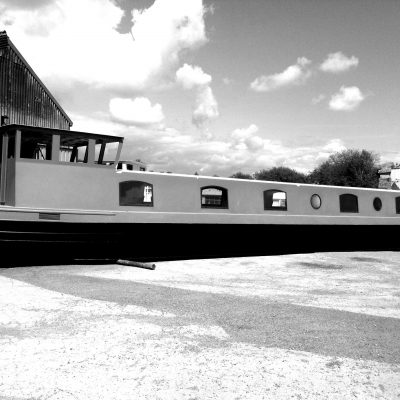
Here at the Sailaway Boat Company, it’s no longer is it a question of creatively trying to fit the kitchen sink into the wardrobe and going without the modern life necessities.
We’ve seen first-hand how tastes have changed over our years of boat building. Over recent years we have been attracting lots of interest with our wide beam hulls, it’s even why we recently moved locations to placate our customers demand.
At the Sailaway Boat Company we specialise in bringing your passion for wide beam boats alive, giving you a boat with the flexibility and convenience of any modern apartment. So whether you are looking for something suited for living aboard or where you want upgrade and have the extra space and flexibility, we’re the business for you.
So whatever your adventure; enjoy of living in the slow lane on a wide beam boat proudly built by us made to suit your exacting specifications as the world goes by at 4mph
We have particular expertise and knowledge of city centre and long-term live boards so if you’re thinking about buying and living on a wide beam as a great alternative to a cramped apartment; come and have a chat. Our wide beam hulls are all unique in their own right, nevertheless with all our boats. Our expert craftsman will be pleased to suggest ideas to complement your own and to find the most appropriate design to suit your interest, time and budget. The only limit is imagination.
Built to order our Hull only options are great value for the more experienced and valued trade customers.
Our Sailaway range of wide beam canal boats are designed to give the perfect head start for those looking to undertake their own internal fit-outs.
SAILAWAY LINED
You can be confident when you speak to us that you’re speaking to an expert craftsman who fully understands your love of boating and desire for a stress free building experience.
FULL FIT & BESPOKE
We can build wide beams to any length, style or stage of completion; come and see us and we will design your boat together. for more information call us today on 0115 888 2104.
As well as our typical specification options we also offer a great range of accessories from Portholes, extra security fixtures to Stainless Steel Water tanks and much more. To find out more about our expert wide beam building services that we can offer you, call us today.
All the standard shell specifications :
- Engine supplied and fitted to suit the size of vessel.
- Windows and/or Port Holes supplied and fitted.
- Roof vents supplied and fitted. Lower level door vents supplied and fitted.
- Baton and Spray foam insulated.
- Ballast and 18mm Plywood floor.
- Stainless steel water tank Supplied.
- Ready to be delivered and sail away.
Steel work made from 10mm Base, 6mm Hull sides, 5mm Cabin, 4mm Roof.
- Fender Eyes
- Rear Sliding Hatch with rear Doors
- Integral Hand Rail Centre Roof Ring
- All Rubbing Bars 2” Wide, Welded Top AND Bottom
- Front Door’s
- Stainless barrel hinges all round
- Integral Gas Locker & Integral Diesel Tank
- Painted in High build Grey Zinc Base Primer
- 2 Pack Black on the Hull
UNRIVALLED EXPERIENCE
Buy with confidence.
Please be rest assured all our new boats come with a full comprehensive warranty & ancillary equipment warranties allowing you to purchase with confidence.
BRITISH BUILT
We use only the highest grades of materials and quality British craftsmanship for our bespoke canal boats, ensuring that your boat will be one of the best built steel boats in the UK
SUPPORT WHEN YOU NEED IT
From one-off technical advice, transport organisation to ongoing hull maintenance support; we can ensure help is always at hand as no-one else knows the boat better than the craftsman that created her.
Want to know more about what we can do? We’d love to work with
DESIGN YOUR OWN BOAT
Let us build it for you.
Our Sailaway range of widebeam canal boats are designed to give the perfect head start for those looking to undertake their own internal fit-outs. As standard we offer generally three types of Sailaways built to various levels of completion, accommodating various budgets. If you would like to build on our standard specifications talk with anyone of our team and we’ll create you a quotation meeting your exact requirements.
LET’S MAKE SOMETHING GREAT TOGETHER !
Have a project in mind and want to talk to one of the team get in touch with us., at a realistic price, we build beautiful and handcrafted widebeam hulls..
We have a very simple philosophy here at The Sailaway Boat Company ; Produce beautiful canal boats. That’s it, no bells and whistles, no hidden extras we just want to produce exceptional boats at realistic prices.

Best in British Craftsmanship
Not all boats are created equal: our quality is the difference and we would like you to be as proud of your boat as we are. at the sailaway boat company you’ll find a friendly business that knows and loves boats inside out with our wealth of experience that goes into every boat; ensuring great client satisfaction and many proud years of boating pleasure..
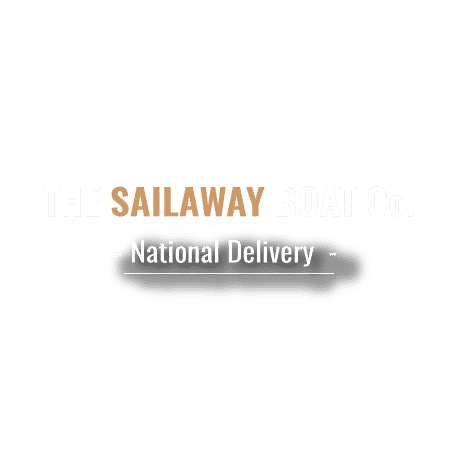
Come and say hello
Why not come and see for yourself.
Here at the Sailaway Boat Company, we would also recommend that prior to visiting us; is to actual go and visit other boat builders to see for yourself and to thoroughly appreciate the attention of detail and finesse we give to every boat we build. We create high quality wide beam boats which we will be both proud of and a delight for you to own; allowing you to buy with confidence and peace of mind.
Small Details Make a Big Impression! Low Prices | Quality Guaranteed | Excellent Services
Buy with confidence, looking for a truly handcrafted bespoke wide beam boat.
So whatever your wide-beam adventure: we can offer a variety of boat styles so we can fully provide you with the perfect mix of aesthetics and function to suit your individual needs and with our exceptional after sales service giving you the ability to buy with confidence and ensure you get a great start to many years of happy boating.

Interested in buying a WIDE BEAM boat? Want some more information about our boats?
Why choose us, we've got you covered.
All our boats will come with a comprehensive hand book and certification with all the work carried out by The Sailaway Boat Co. Included with this is your HIN (Hull Identification Number) And a Certificate of conformity.
Competitive Prices
“Quality Service, Quality Boats made to the highest standard. We will not be beaten on price.” That’s it, no bells and whistles, no hidden extras we just want to produce exceptional boats at realistic prices!
Built with Confidence
Manufacturing for almost 30 years; our professional experience and passion for boating transcends into everything we build. You can be confident when you speak to us that you’re speaking to an expert craftsman who fully understands your love of boating.

- The Hull Range
- The Sailaway Range
- Sailaway Lined Range
- The Shearwater Narrow Beam
- The Abode Range
- The Euro Cruiser Range
- Monarch Emperor Range
- The Pioneer Range
- The Hoxton Range
- CURRENT AVAILABILITY
- Buyers Guide
- Build Process
- Latest News
- Useful Information
- General Information
- Canal Network
- FAQ’s
- GET IN TOUCH

We value your data, please tick here to confirm your consent. For more information on your privacy please refer to our privacy notice .

A guide to buying a wide beam boat
Widebeam boats are perfect if you are planning to transform the boat into your home. They come with ample built-in storage spaces and individual rooms so you can live comfortably – quite similar to a small apartment.
Although the extra width does put a restriction on your cruising range, there are still many beautiful spots in the UK you can visit.
So, what is a wide beam boat?
Widebeam boats have become popular in the UK waterways as more and more people are choosing to get away from the hustle and bustle of city life and enjoy the peace and tranquillity of onboard living. It also gives the option for people to travel as much as they like and explore the countryside scenery along the way.
A wide beam boat is based on the style of a standard narrowboat, i.e they both are constructed with robust steel. However, the difference is that wide beam boats are a lot wider inside and offer a lot more room allowing the installation of contemporary fit-outs.
With all the extra space, wide beam boats offer a comfortable home for those who wish to live onboard and prefer not to cruise as much. Some canals on the network don’t accommodate for the size of a wide beam boat, so it’s always best to do your research if you plan to move.
What are the main differences between a wide beam and a narrowboat?
Both of these boats share similar characteristics and functionalities. Both boats start off the same, but then the wide beam boat is made wider to accommodate for extra space.
A standard narrowboat size: 6 foot 10 inches A standard wide beam boat size: 10-12 feet wide
Cruising limitations
Narrowboats can pretty much cruise in any canal in the UK, however, wide beam boats are unable to navigate along the smaller canals.
Why should you invest in a wide beam boat?
- Offers extra storage and living space
- Comfortable and large with an apartment like feel
- Option to install contemporary fit-outs
Why a narrowboat may be the better option for you?
- If you prefer to constantly cruise and move around. Widebeam boats are limited due to their width
- If you are on a budget. Widebeam boats come with higher costs for licences, mooring etc.
- If you prefer the traditional boat look. Widebeam boats are more contemporary and modern.

We understand that for first time buyers, the world of canal boats can cause a little confusion. In order to facilitate things, Collingwood have put together this handy guide; ensuring you end up with the boat of your dreams.
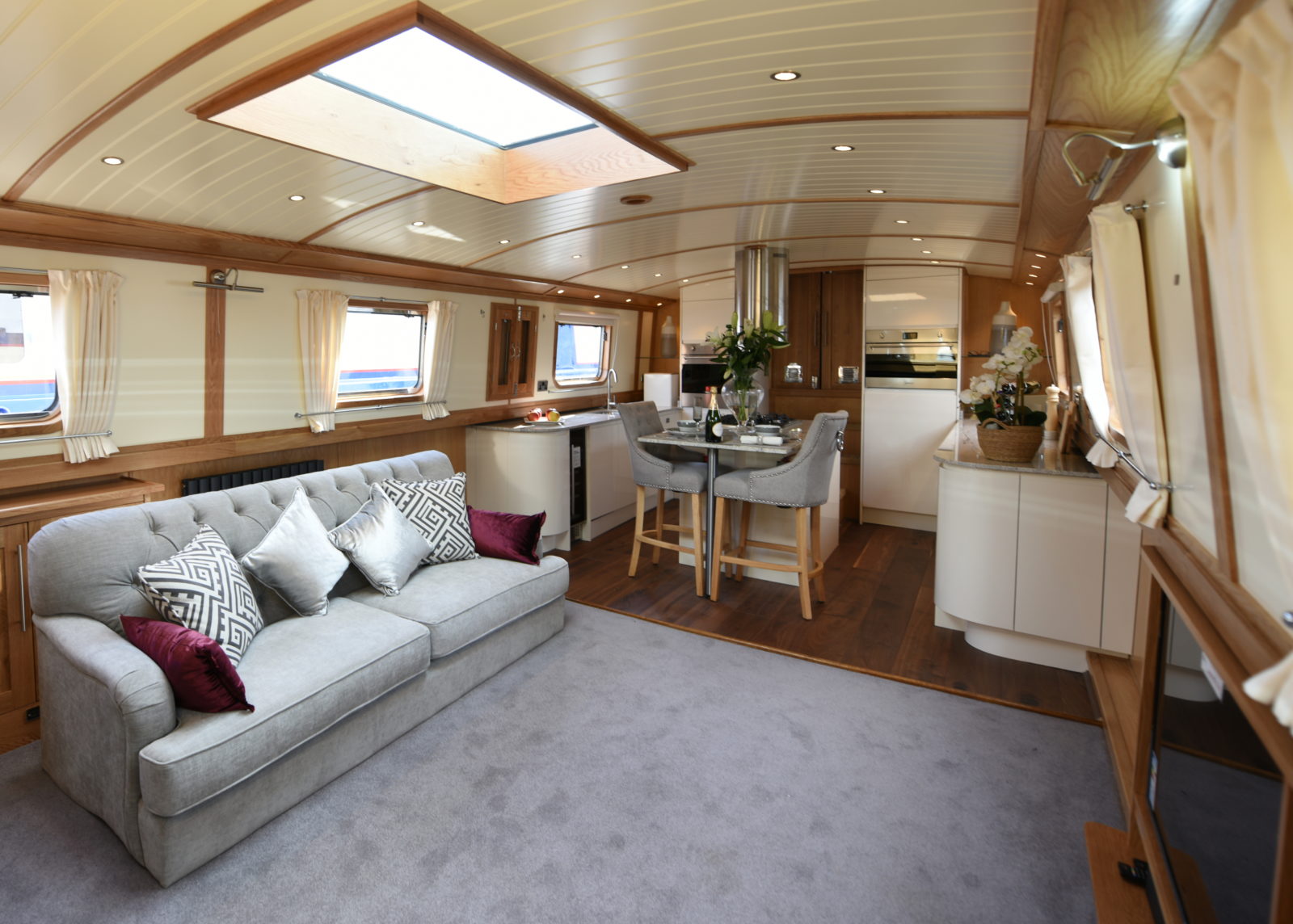
Although we are still in the early stages of taking the delivery of our new 66 / 12 Wide beam boat, the communication, service and workmanship has been outstanding, if we all took the Collingwood Boat approach, we would all be better off! If your thinking of having a boat built, talk to these guys first, you won’t be disappointed. Very pleased!

As the proud home of boat building heritage, Liverpool has always been synonymous with the craftsmanship that goes into creating narrowboats and widebeam boats....
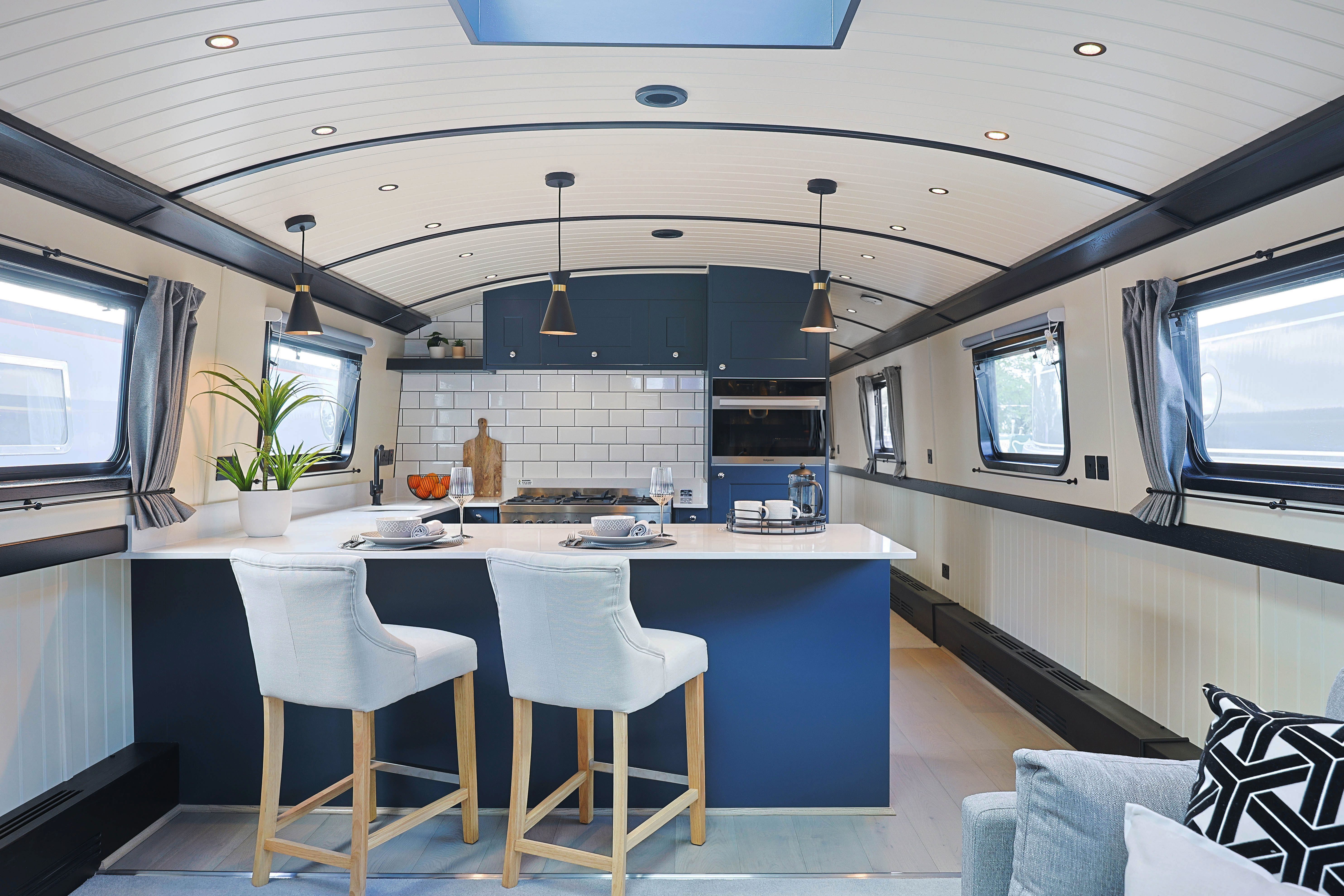
So you’ve purchased a Sailaway canal boat with the intention of fitting out the interior yourself. Whether you’re the proud owner of a brand...
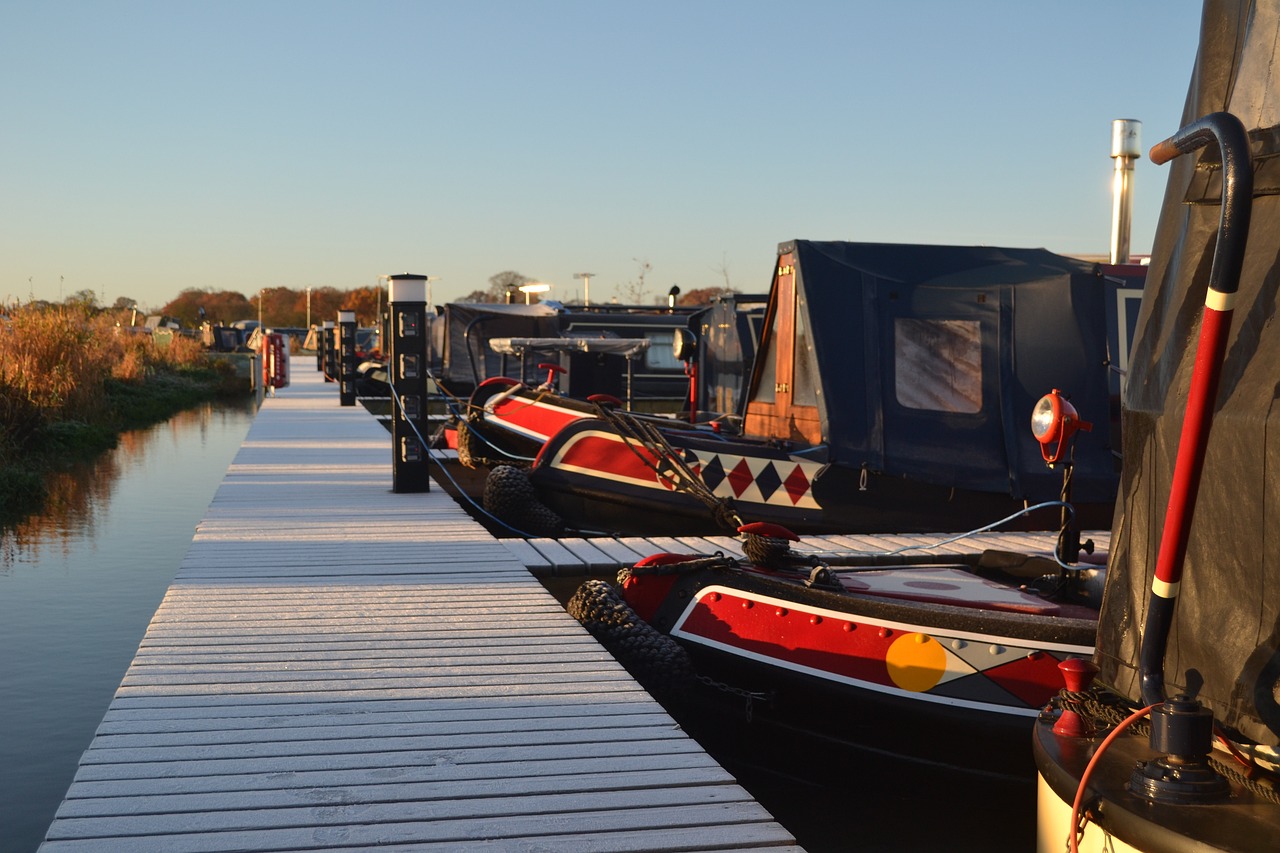
The Leeds and Liverpool Canal is a historic waterway that stretches for 127 miles, connecting the cities of Leeds and Liverpool in the United...
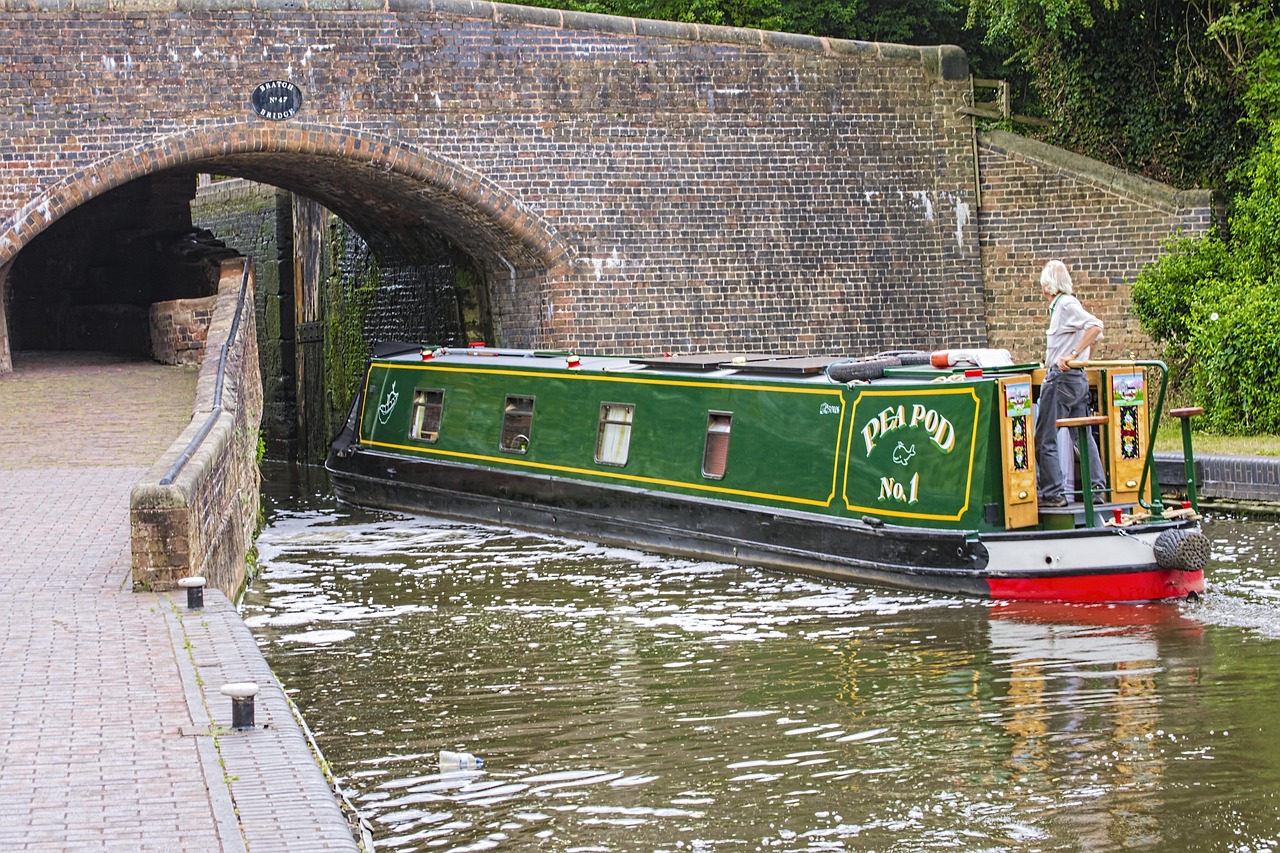
Whether you’re a regular canal journeyman or you’re experiencing cruising the UK waterways for the first time, when embarking on a canal boat cruise,...

To start design work on your very own canal boat build or to find out more, get in touch with us today.
What boat are you interested in?
NARROW BEAM WIDE BEAM
How will you use your canal boat?
LIVE ABOARD LEISURE
Size of boat.
Select fit out option.
SHELL SAILAWAY SAILAWAY LINED SAILAWAY LINED ADDITIONS FULLY FITTED
Any additional details.
Collingwood Boat Builders 72 St Johns Road Liverpool L20 8BH

Want to know whats new, get in touch for email updates.
©2024 Copyright - Collingwood Boat Builders - Privacy Policy - Cookies

Website By unity .
Privacy Overview

IMAGES
VIDEO
COMMENTS
Boats for sale ⁄ / Wide Beam Narrowboat; Wide Beam Narrowboat boats for sale. Create Search Alert. Clear Filter Make / Model: All Wide Beam Narrowboat. Location. By Radius. By Country. country-all. All Countries. Country-GB. United Kingdom. All. All 25 miles 50 miles 100 miles 200 miles 300 miles 500 miles 1000 miles 2000 miles 5000 miles.
These sailboats have a minimum total sail area of 292 square feet, a maximum total sail area of 2,192 square feet and an average of 815 square feet. Boat Trader currently has 789 cruiser sailboats for sale, including 225 new vessels and 564 used and custom yachts listed by both private sellers and professional yacht brokers and boat dealerships ...
Apollo Duck, Collingwood 60 Widebeam Narrow Boats For Sale curls shirls 60ft collingwood widebeam, Collingwood 60 Widebeam Narrow Boats For Sale 2016 collingwood 60ft wide beam, Other Narrow Boats For Sale bespoke 55 039 wide beam 039 shard 039 , Northwich Boat Co 45 Widebeam Narrow Boats For Sale rare 45 x 12 widebeam for sale, Other Narrow Boats For Sale lilly anna 60 widebeam, XR&D 60 ...
It has a wide beam, a lot of interior space, all of the amenities a comfy cruiser should have, such as a big refrigerator with a freezer, as well as a fully equipped kitchen. The long keel here serves as a comfort helper, since, as mentioned before, it adds to the stability and reduces motion. ... Boats usually evolve, sailors' feedback is ...
After a 30 year absence, a veteran marine journalist returns to the US Sailboat Show and discovers the many changes in cruising boat design and construction. By Dan Spurr. Updated: June 10, 2020. The X-Yachts 46 displays the wide beam, twin wheels and open transom that define many 2020 models. Jon Whittle.
Filter our widebeam boats by price, size or location to discover widebeam canal boats for sale in Nottinghamshire, London and around the UK. To contact our boat sales team, call us on 01455 249000 or send us your details here for a call back. Filter 1. Recommended.
Viking 26. TheViking 26 wide beam is the flagship of the range. If it's more time afloat you're after enjoying long term cruising, theV26 wide beam ticks all the boxes. Length 7.80 metres 25ft. 6". Beam 2.8 metres 9.2ft.". Cabin Headroom 1.9 metres 6ft. 3". Berth 6 People.
What makes the Flicka 20 stand out is its exceptional bluewater performance. This sailboat is truly an ultracompact pocket cruiser. With a full ballast keel, self-draining cockpit, and wide beam, the Flicka 20 is more capable offshore than some boats almost twice its size. This sailboat has the profile of a traditional keel cruiser.
2013 Wide Beam Narrowboat 57' x 10'. US$164,204. US $1,297/mo. Tingdene Boat Sales Ltd | Stourport-on-Severn, Worcestershire. Request Info. <. 1. >. * Price displayed is based on today's currency conversion rate of the listed sales price.
Narrowboats and widebeams share a lot of the same characteristics. That's because they're made by the same boat builders who take the simple narrowboat design and just build it wider! Rather than the standard narrowboat width of 6 foot 10 inches, a widebeam boat can be between 10 and 12 feet wide. While narrowboats can cruise anywhere on UK ...
2007 Wide Beam Narrowboat Metrofloat 60 x 11 Wide beam. £114,950. ↓ Price Drop. Tingdene Marinas and Boat Sales - Thames and Kennet Marina Office | Reading, Berkshire. Request Info. In-Stock.
Hydra - £89,950. Hydra is a 60ft long x 10ft wide, wide-beam built by Viking Canal Boats in 2011. She is fitted with a Beta Marine 60HP inboard diesel engine, has 4 berths and a bow thruster. Hydra is an exceptional cruiser stern wide-beam and benefits from spray foam insulation, fixed double Queen size bed and double sofa bed, quadrant shower ...
Wide Beam boats . Gallery. View the Gallery . View the Gallery . What they said "We chose Bespoke Boat Co. to build our widebeam over others because of their professional attitude quality of service. They have fully lived up to their word and build us a stunning widebeam with unprecedented attention to detail. I'd 100% recommend them."
Plus, the boat has quite a wide beam, great ballast/displacement ratio as well as low sail area/displacement ratio, making it a stiff boat under sail, which adds to stability and comfort. Good condition MkIII Catalinas can be found for about $35,000, but given the volume of these on the market, you can find a usable one even for around $15,000. ...
2007 Wide Beam Narrowboat Metrofloat 60 x 11 Wide beam. US$147,803. ↓ Price Drop. US $1,157/mo. Tingdene Marinas and Boat Sales - Thames and Kennet Marina Office | Reading, Berkshire. Request Info. <. 1.
Wide Beam Boats. Our wide beam boats are designed to meet the demands of those requiring a 'little' more space than the traditional narrowboat can offer without suffering any compromise on the quality and finish of the boat. Our Mayfair wide beam still offers the same excellent quality of craftsmanship and level -of fit-out that Elton Moss ...
We often get asked about the pros and cons of owning a wide beam versus a narrowboat and how restricted we are in terms of cruising the network on a wide bea...
At the Sailaway Boat Company we specialise in bringing your passion for wide beam boats alive, giving you a boat with the flexibility and convenience of any modern apartment. So whether you are looking for something suited for living aboard or where you want upgrade and have the extra space and flexibility, we're the business for you.
Year. Wide beam canal boat for sale on DailyBoats.com are listed for a range of prices, valued from $42,176 on the more basic models to $114,729 for the most expensive. The boats can differ in size from 10.67 m to 18.29 m. The oldest one built in 1990 year. This page features Evans & Sons and Wide Beam boats located in countries: United Kingdom.
From Rickmansworth, a boat may travel north up the Grand Union, but at Leighton Buzzard there is a lock that is only 3.81 metres (12 ft 6 in) wide. So any boat with a beam of 4.22 metres (13 ft 10 in) able to navigate canals and rivers in and around London will be unable able to proceed further north.
Pros:-. Spacious: One advantage you will always get with wide beam boats, is the amount of space they offer. The additional living space is ideal for small families and allows a lot of options for storage. Check out our Abode range of boats for scope, it's one of our top specification designs and comes complete with a variety of technical ...
A wide beam boat is based on the style of a standard narrowboat, i.e they both are constructed with robust steel. However, the difference is that wide beam boats are a lot wider inside and offer a lot more room allowing the installation of contemporary fit-outs. With all the extra space, wide beam boats offer a comfortable home for those who ...
Images: 3. Depends what you are after. Some sweeping generalisations: If you want to go fast - it matters - wide & flat (like a boat designed within the most "Open" box rules) are likely to be much faster off the wind. If you want comfort - it matters - the narrow beam of the older designs are likely to be more comfortable in a sea.